Using the latest Zillow Home Value Index data from, we’ve ranked the 30 most expensive towns in Nebraska based on current home prices. These communities represent the cream of Nebraska’s housing market, where values have climbed dramatically over the past 15 years. Home prices in these towns don’t just reflect current demand—they tell stories of growth, location advantages, and local amenities that buyers find irresistible.
From tiny rural villages that have quietly appreciated to established suburbs near Omaha and Lincoln, each town on this list offers something special. Property values range from just under $400,000 to more than $650,000, with some communities showing price increases exceeding 200% since 2010. Whether you’re considering a move, tracking investment opportunities, or simply curious about Nebraska’s real estate market, this ranking reveals where the state’s most valuable properties are located.
30. Valparaiso – 117% Home Price Increase Since 2010
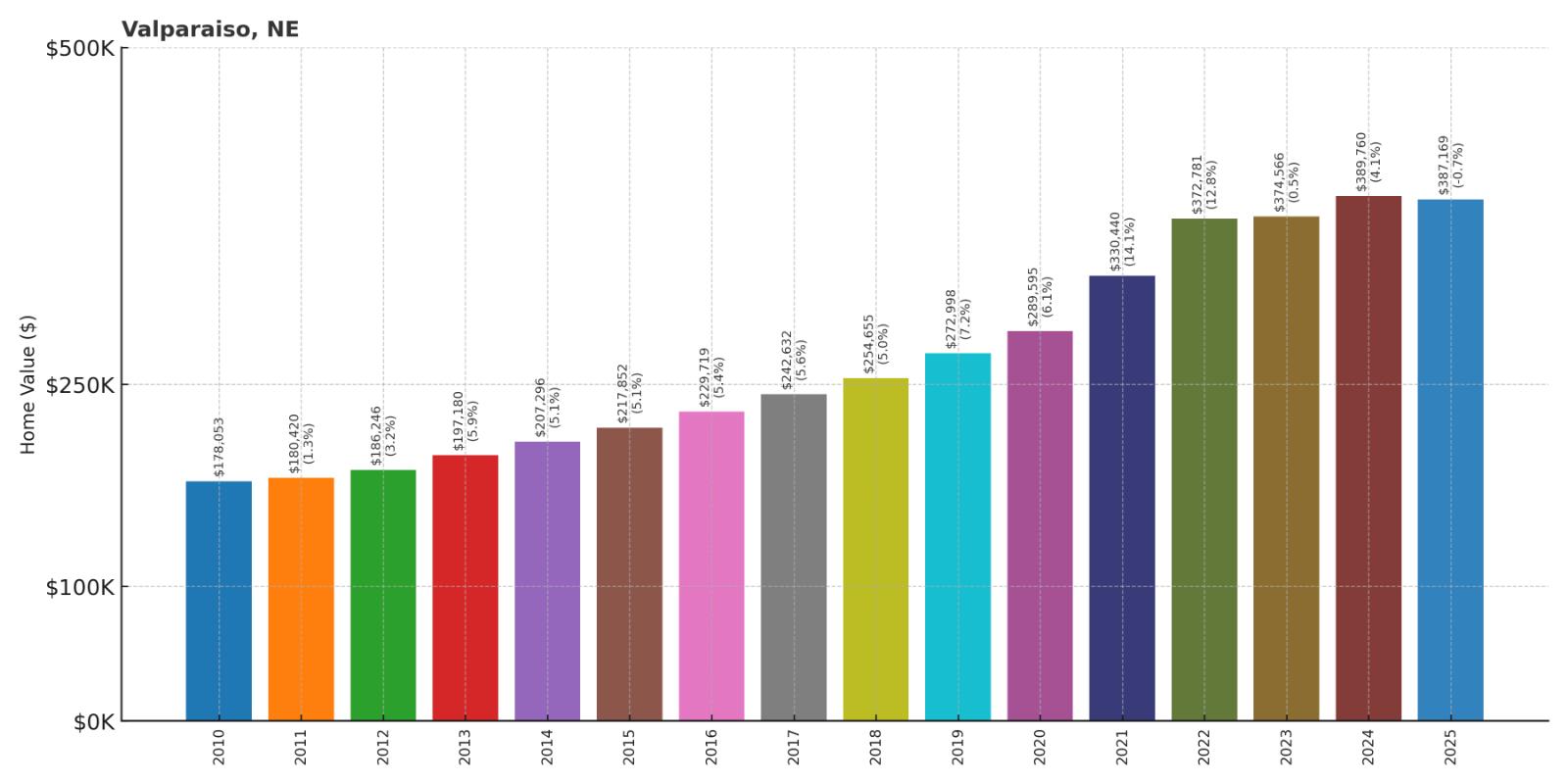
- 2010: $178,053
- 2011: $180,420
- 2012: $186,246
- 2013: $197,180
- 2014: $207,296
- 2015: $217,852
- 2016: $229,719
- 2017: $242,632
- 2018: $254,655
- 2019: $272,998
- 2020: $289,595
- 2021: $330,440
- 2022: $372,781
- 2023: $374,566
- 2024: $389,760
- 2025: $387,169
Valparaiso has shown remarkable consistency in its housing market growth since 2010, more than doubling in value over 15 years. The town experienced its strongest acceleration during the pandemic years, with prices jumping nearly $100,000 between 2020 and 2022. Despite a slight pullback in 2025, home values remain well above pre-pandemic levels, demonstrating the area’s lasting appeal.
Why Valparaiso?
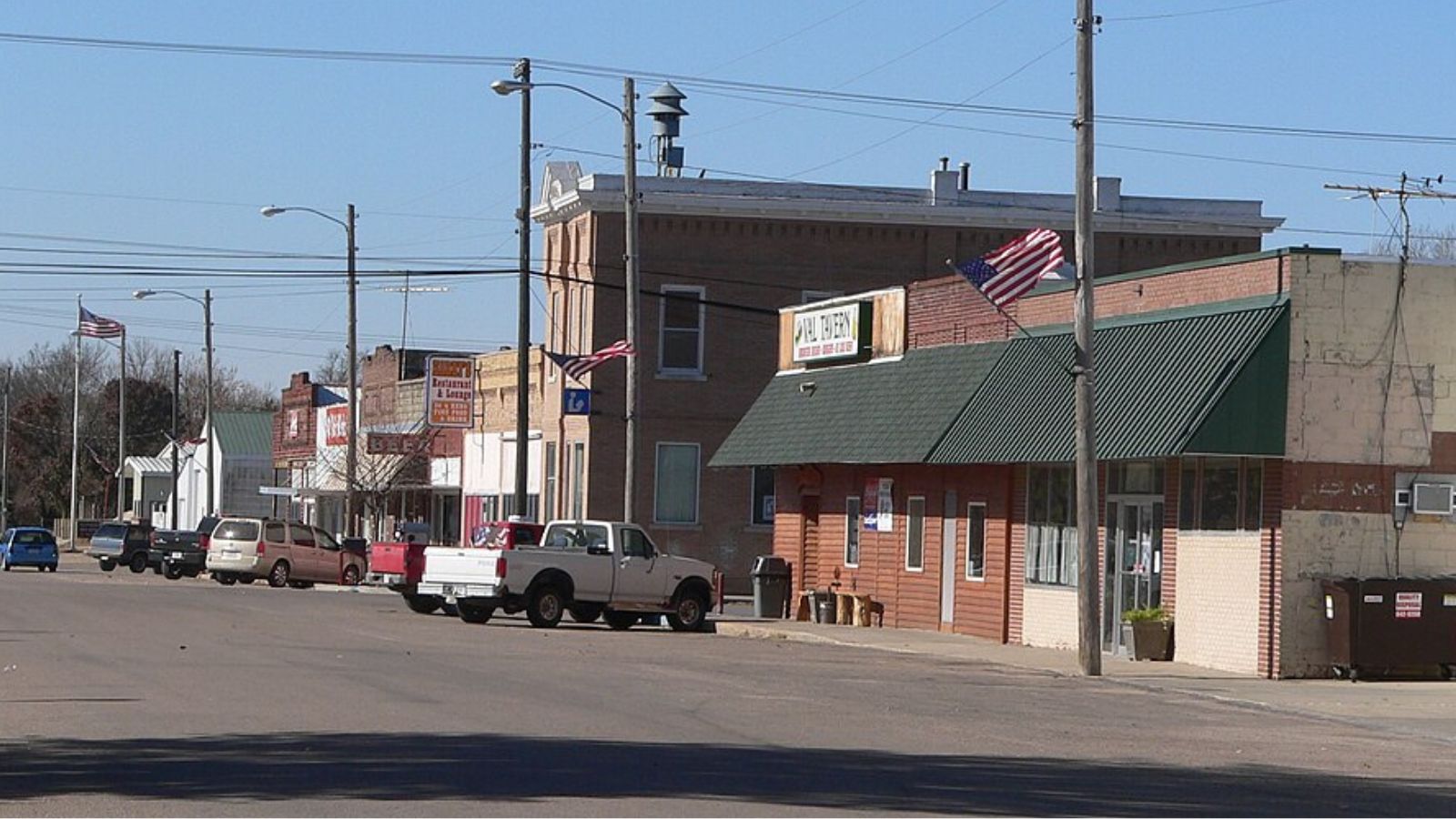
Why are people willing to pay so much to live here? What’s special about it?
Valparaiso attracts residents with its small-town charm and proximity to Lincoln, just 20 minutes away via Highway 6. Families appreciate the excellent Waverly School District, which consistently ranks among Nebraska’s top performers. The community offers a perfect balance of rural living with suburban conveniences, including well-maintained parks and recreational facilities.
The town’s strategic location in Saunders County provides easy access to both Lincoln and Omaha employment centers while maintaining affordable property taxes. Quality construction and newer subdivisions have drawn buyers seeking more space and value than urban areas provide. Valparaiso’s steady growth reflects its reputation as a safe, family-friendly community with strong schools and community involvement.
How Valparaiso Rose to Prominence
Originally founded as a railroad town in the 1880s, Valparaiso evolved from an agricultural hub into a bedroom community as Lincoln’s metropolitan area expanded westward. The town’s name, meaning “Valley of Paradise” in Spanish, reflects early settlers’ optimism about the fertile land and promising location. For decades, Valparaiso remained a quiet farming community with modest growth.
The transformation began in the 1990s as improved transportation corridors made commuting to Lincoln more feasible, attracting families seeking affordable housing and quality schools. New residential developments emerged throughout the 2000s, bringing modern amenities while preserving the community’s small-town character. The town’s careful planning and commitment to maintaining its rural feel while accommodating growth has made it increasingly desirable for buyers priced out of Lincoln’s housing market.
3 Interesting Tidbits
1. Pioneer Heritage – The town features a historic depot that once served the Burlington Railroad, now preserved as a reminder of Valparaiso’s transportation roots.
2. School Pride – Valparaiso feeds into the Waverly School District, which has won multiple state championships in athletics and academic competitions.
3. Community Events – The annual Valparaiso Days celebration brings together residents for parades, live music, and local food vendors, strengthening neighborhood bonds.
29. Pleasanton – 38% Home Price Increase Since 2021

- 2010: N/A
- 2011: N/A
- 2012: N/A
- 2013: N/A
- 2014: N/A
- 2015: N/A
- 2016: N/A
- 2017: N/A
- 2018: N/A
- 2019: N/A
- 2020: N/A
- 2021: $284,373
- 2022: $327,405
- 2023: $351,834
- 2024: $372,982
- 2025: $393,258
Pleasanton represents one of Nebraska’s newer housing markets, with data beginning in 2021 during the pandemic housing boom. The community has shown consistent year-over-year growth, gaining nearly $109,000 in median home value in just four years. This rapid appreciation reflects the town’s growing popularity among buyers seeking affordable alternatives to larger metro areas.
Why Pleasanton?
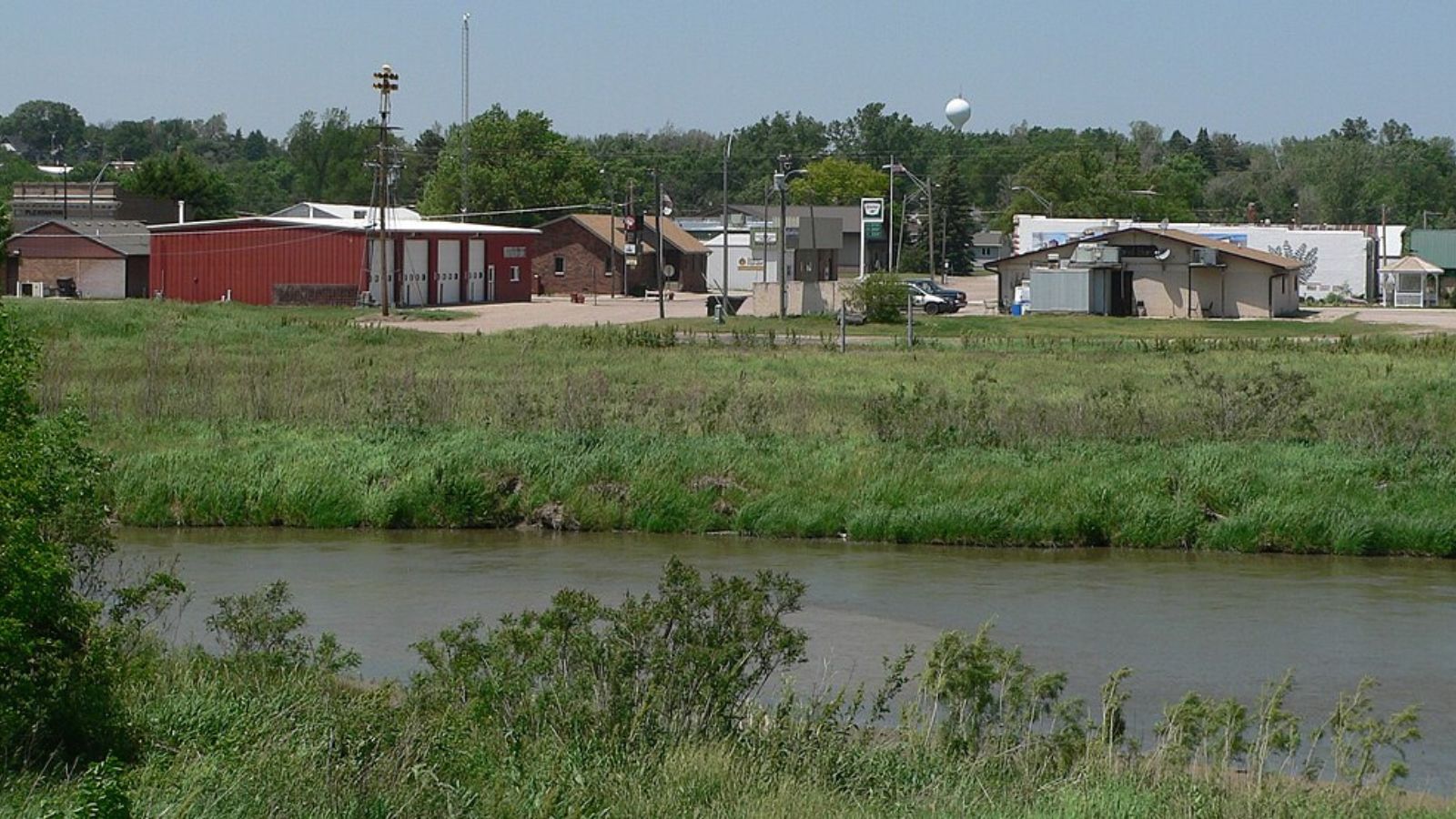
Why are people willing to pay so much to live here? What’s special about it?
Pleasanton offers buyers a rare combination of rural tranquility and modern conveniences in south-central Nebraska. The community attracts families and retirees with its low crime rates, friendly atmosphere, and reasonable cost of living compared to urban areas. Buffalo County’s agricultural economy provides stability, while the town’s location offers easy access to larger cities when needed.
Housing options include both historic homes and new construction, giving buyers variety in their choices. The town’s commitment to maintaining its small-town character while adding modern amenities appeals to those seeking authenticity without sacrificing convenience. Strong community involvement and volunteer-driven events create a tight-knit social environment that many find missing in larger communities.
How Pleasanton Rose to Prominence
Founded in the late 1800s as an agricultural settlement, Pleasanton grew slowly but steadily around farming and ranching. The community remained largely stable for most of the 20th century, with modest population growth tied to local agricultural prosperity. Railroad connections provided vital links to regional markets, helping sustain the local economy through various economic cycles.
Recent growth reflects broader trends toward rural living, accelerated by remote work opportunities and urban buyers seeking more space and affordability. The town’s location within driving distance of Kearney and Grand Island makes it attractive to commuters, while its agricultural heritage appeals to those seeking a slower pace of life. Investment in infrastructure and community amenities has positioned Pleasanton as an emerging destination for families and retirees alike.
3 Interesting Tidbits
1. Agricultural Heritage – The town sits in prime farming country, with corn and soybean fields surrounding residential areas, maintaining its rural character.
2. Community Spirit – Pleasanton hosts annual harvest festivals that celebrate local agriculture and bring together farmers and townsfolk.
3. Wildlife Haven – The area’s prairie location provides excellent bird watching and hunting opportunities, attracting outdoor enthusiasts year-round.
28. Amherst – 31% Home Price Increase Since 2021
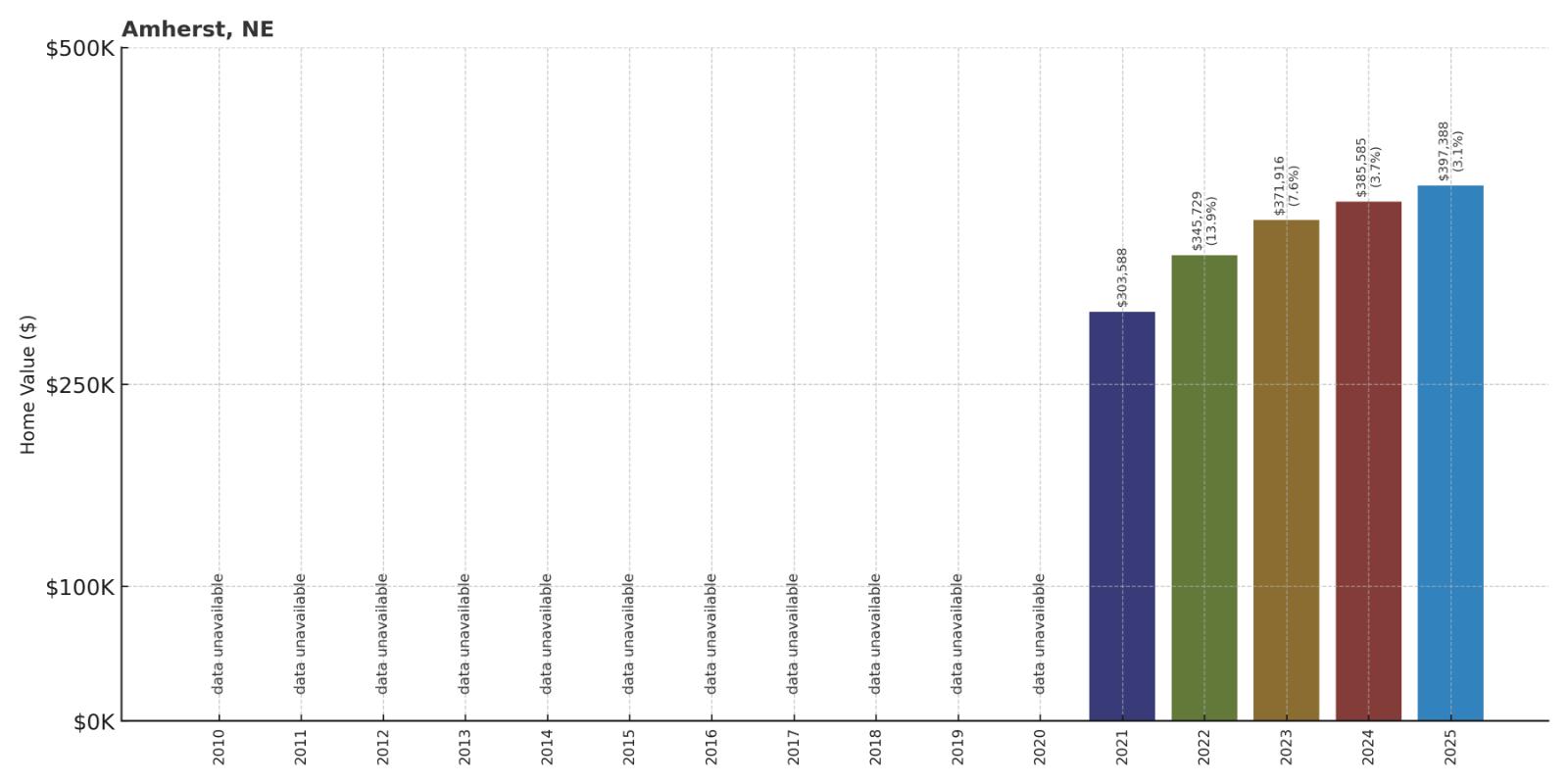
- 2010: N/A
- 2011: N/A
- 2012: N/A
- 2013: N/A
- 2014: N/A
- 2015: N/A
- 2016: N/A
- 2017: N/A
- 2018: N/A
- 2019: N/A
- 2020: N/A
- 2021: $303,588
- 2022: $345,729
- 2023: $371,916
- 2024: $385,585
- 2025: $397,388
Amherst has demonstrated steady appreciation since data collection began in 2021, with home values climbing nearly $94,000 in four years. The growth pattern shows consistent annual increases, with the largest jump occurring in 2022 during the height of the pandemic housing surge. Current values reflect the town’s position as an affordable option in Buffalo County with good growth potential.
Why Amherst?
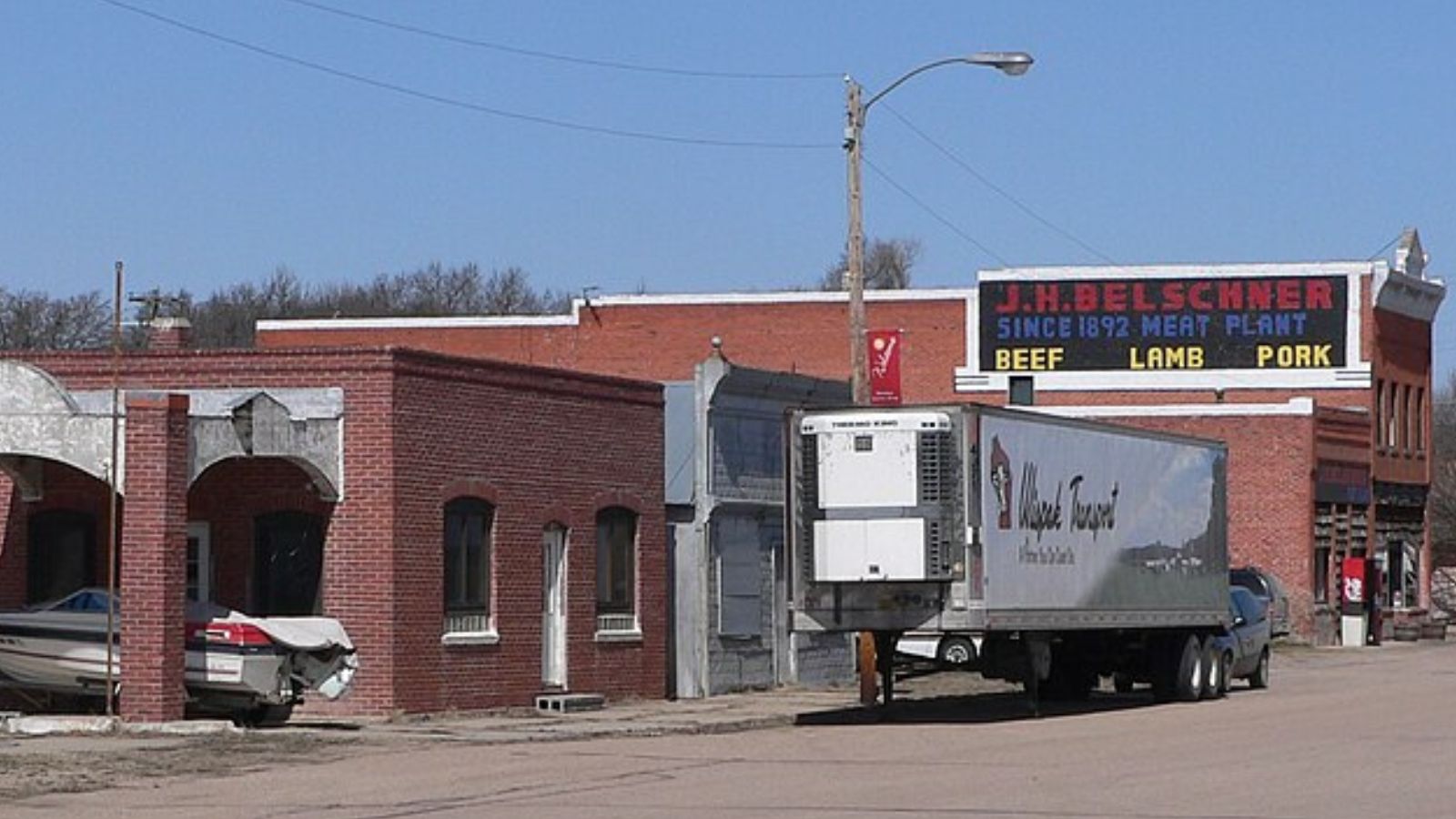
Why are people willing to pay so much to live here? What’s special about it?
Amherst appeals to buyers seeking small-town living in central Nebraska’s agricultural heartland. The community offers affordable housing compared to larger cities while maintaining access to employment opportunities in Kearney and Grand Island. Families value the safe environment, quality local schools, and strong community connections that larger towns often lack.
The town’s location along Highway 183 provides convenient transportation access, while its size creates a close-knit community where neighbors know each other. Local businesses and services meet daily needs, reducing the requirement for frequent trips to larger cities. Amherst’s combination of rural charm and practical amenities attracts both young families and retirees looking for authentic small-town living.
How Amherst Rose to Prominence
Established in the 1880s during Nebraska’s railroad expansion, Amherst developed as a service center for surrounding farms and ranches. The town’s location on the Chicago, Burlington and Quincy Railroad made it a shipping point for agricultural products, fostering steady growth through the early 1900s. Like many rural Nebraska communities, Amherst faced population challenges during the agricultural consolidation of the mid-20th century.
Recent interest in the community stems from shifting housing preferences and remote work opportunities that allow people to live in smaller towns while maintaining urban employment. The town’s affordable housing stock and rural lifestyle appeal to buyers priced out of larger markets. Investment in community infrastructure and maintaining local businesses has helped Amherst remain viable and attractive to new residents.
3 Interesting Tidbits
1. Railroad Legacy – Historic grain elevators still dot the skyline, serving as reminders of the town’s agricultural transportation heritage.
2. Community Gardens – Residents maintain shared growing spaces that supply fresh produce and foster neighborhood relationships.
3. Star Gazing – The town’s rural location provides excellent night sky viewing with minimal light pollution, attracting amateur astronomers.
27. Creston – 226% Home Price Increase Since 2010
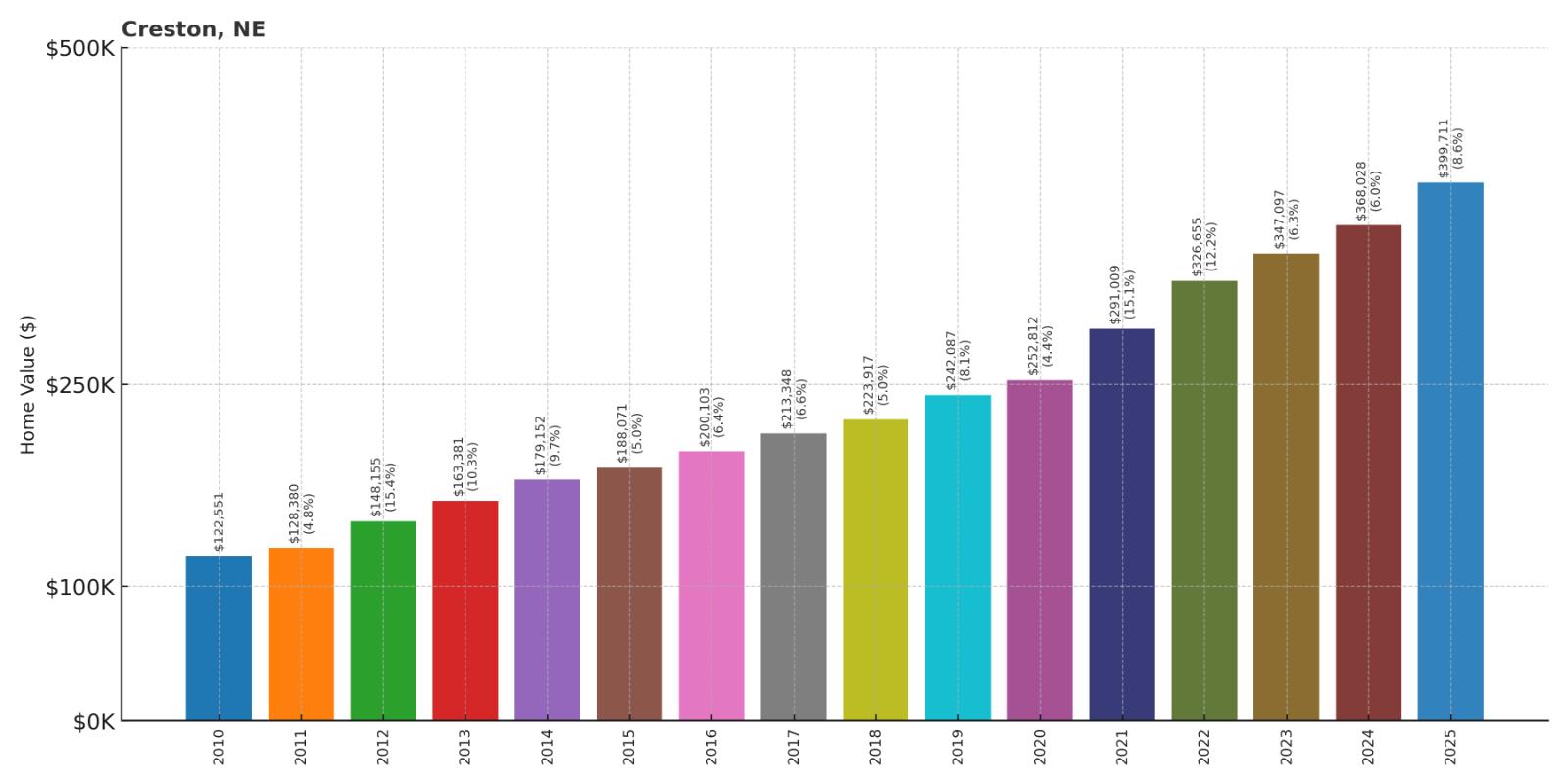
- 2010: $122,551
- 2011: $128,380
- 2012: $148,155
- 2013: $163,381
- 2014: $179,152
- 2015: $188,071
- 2016: $200,103
- 2017: $213,348
- 2018: $223,917
- 2019: $242,087
- 2020: $252,812
- 2021: $291,009
- 2022: $326,655
- 2023: $347,097
- 2024: $368,028
- 2025: $399,711
Creston stands out with the most dramatic appreciation on our list, with home values more than tripling since 2010. The town showed steady growth throughout the 2010s, then accelerated significantly during the pandemic years. This remarkable 226% increase reflects both the community’s growing desirability and its initially modest starting values, creating substantial wealth gains for longtime homeowners.
Why Creston?
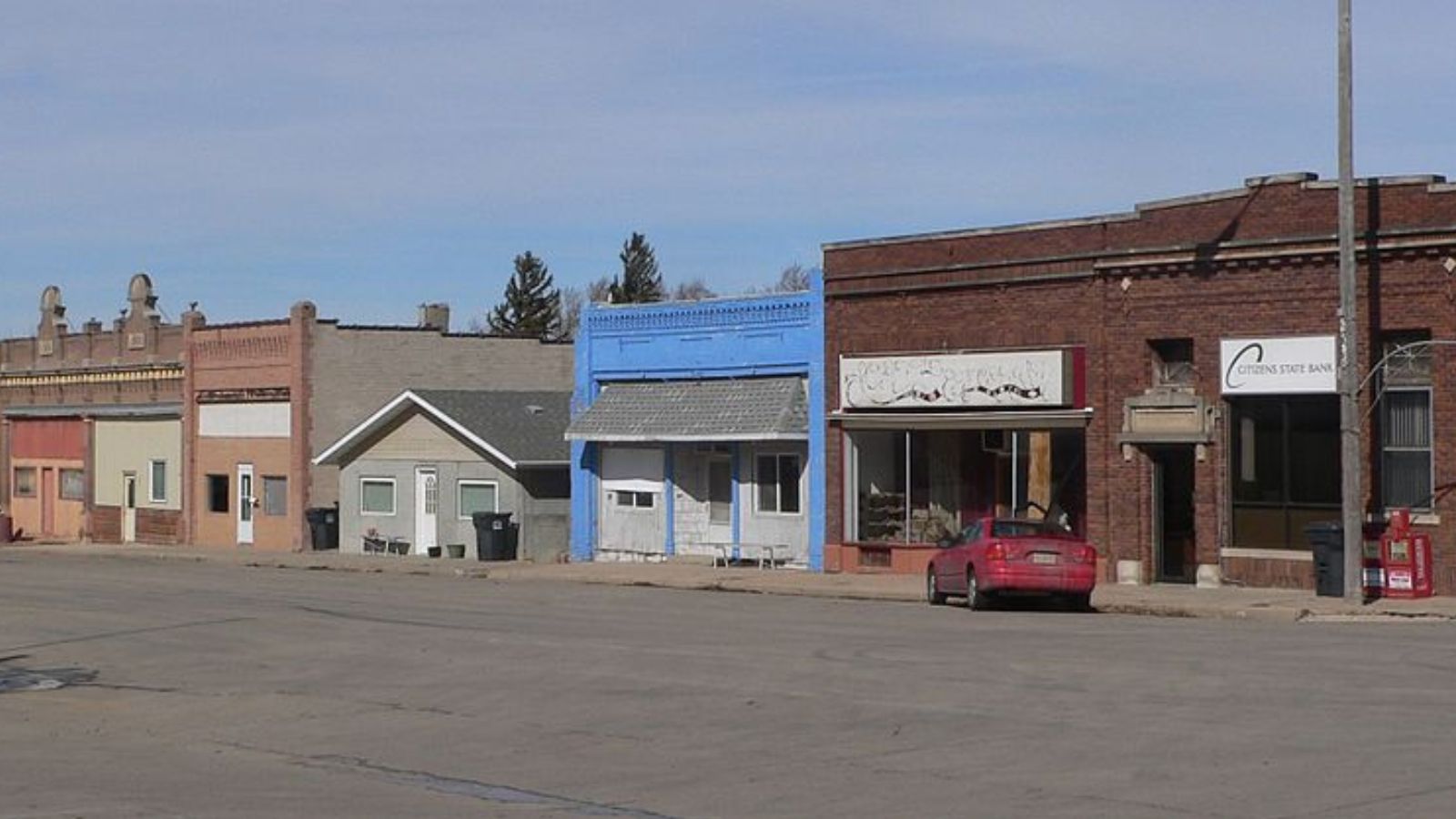
Why are people willing to pay so much to live here? What’s special about it?
Creston attracts buyers with its peaceful rural setting and authentic small-town atmosphere in Platte County. The community offers affordable living costs, friendly neighbors, and a slower pace of life that appeals to families and retirees. Local amenities include parks, community centers, and small businesses that create a self-contained lifestyle for residents.
The town’s agricultural surroundings provide scenic beauty and recreational opportunities, while its location offers reasonable access to Columbus and other regional centers for employment and shopping. Housing options range from historic homes to newer construction, giving buyers choices in style and price range. Creston’s strong community spirit and volunteer involvement create social connections that many urban dwellers find missing in larger cities.
How Creston Rose to Prominence
Founded in the late 1800s as an agricultural settlement, Creston developed slowly around farming and livestock operations typical of central Nebraska. The community remained stable but modest through most of the 20th century, with population tied closely to agricultural prosperity in the surrounding area. Local businesses served farming families and provided essential services for the rural community.
The dramatic price appreciation reflects several factors: extremely low starting values in 2010, increased demand for rural properties during the pandemic, and the town’s growing reputation as an affordable alternative to urban living. Remote work opportunities have made small communities like Creston more viable for professionals, while the community’s authentic character appeals to buyers seeking genuine small-town experiences. Investment in local infrastructure and community amenities has supported this growth trajectory.
3 Interesting Tidbits
1. Prairie Preservation – Surrounding areas maintain original prairie grasslands that provide habitat for native wildlife and serve as natural classrooms.
2. Harvest Traditions – The community celebrates agricultural seasons with festivals that highlight local farming heritage and bring residents together.
3. Small School Excellence – Despite its size, Creston’s school system consistently produces graduates who excel in state academic and athletic competitions.
26. Bennet – 100% Home Price Increase Since 2010
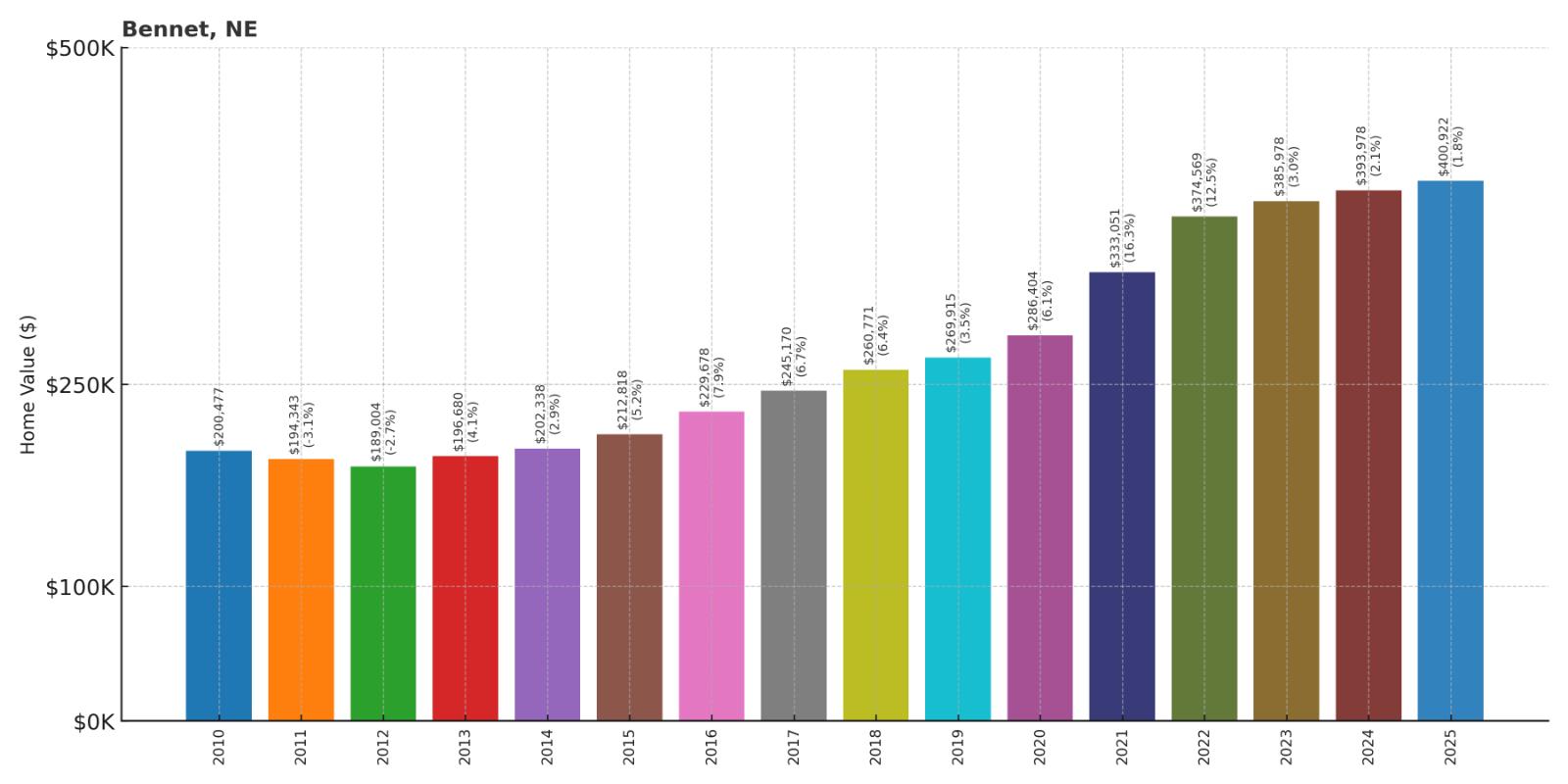
- 2010: $200,477
- 2011: $194,343
- 2012: $189,004
- 2013: $196,680
- 2014: $202,338
- 2015: $212,818
- 2016: $229,678
- 2017: $245,170
- 2018: $260,771
- 2019: $269,915
- 2020: $286,404
- 2021: $333,051
- 2022: $374,569
- 2023: $385,978
- 2024: $393,978
- 2025: $400,922
Bennet achieved exactly 100% appreciation since 2010, doubling home values over 15 years through steady, consistent growth. After some initial volatility in the early 2010s, the town established a clear upward trajectory that accelerated during the pandemic years. The community’s proximity to Lincoln and quality of life factors have sustained demand even as national markets have cooled.
Why Bennet?
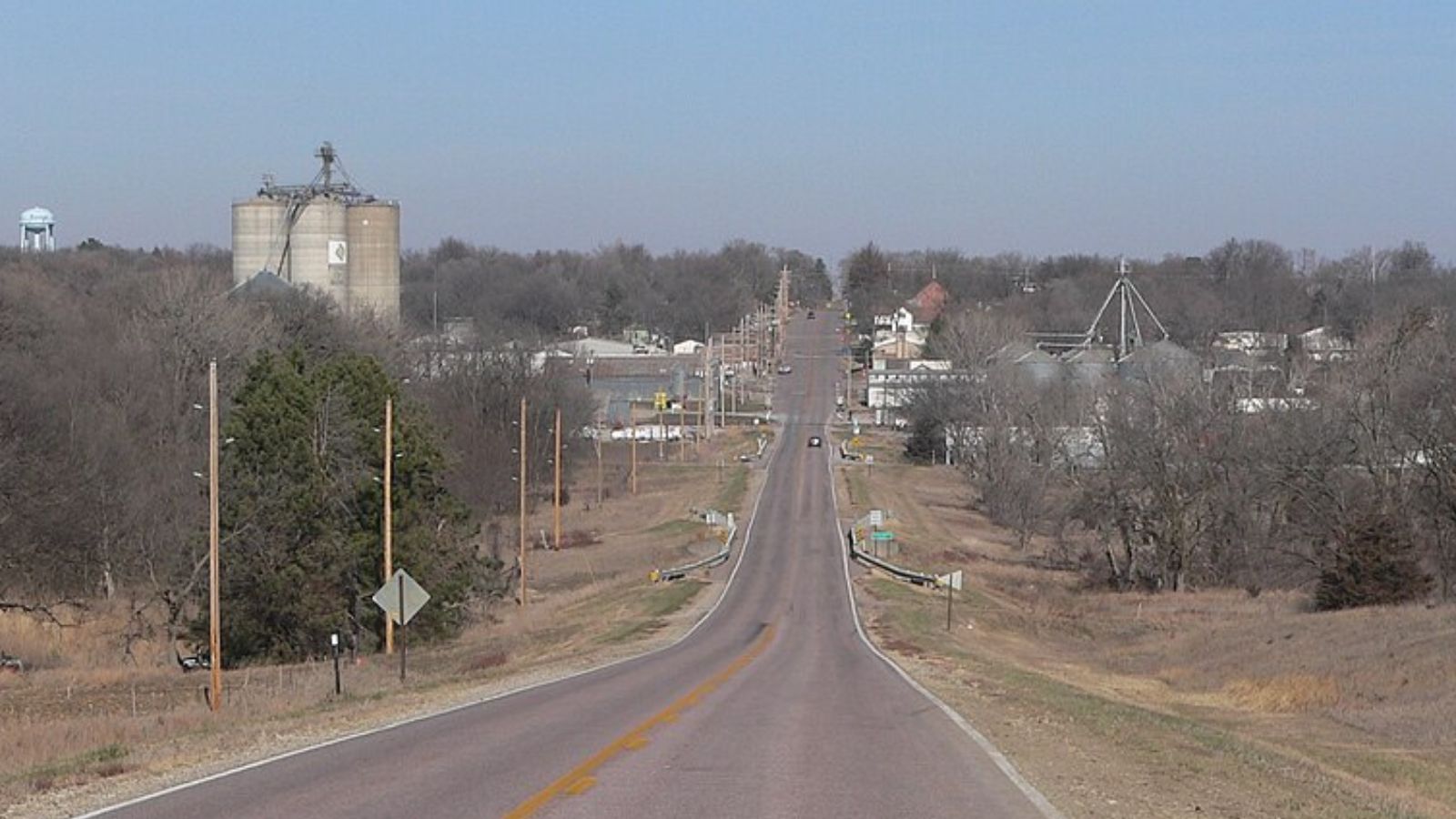
Why are people willing to pay so much to live here? What’s special about it?
Bennet offers residents the perfect blend of small-town living with easy access to Lincoln, just 15 miles northeast. Families are drawn to the excellent Palmyra District OR-1 schools, which consistently rank among Nebraska’s top districts for academic performance and student achievement. The community provides a safe, family-friendly environment with active youth programs and recreational opportunities.
The town’s rural setting features large lots and newer home construction that appeals to buyers seeking space and privacy. Local parks and recreational facilities support active lifestyles, while community events foster strong neighborly connections. Bennet’s location allows residents to enjoy country living while maintaining convenient commutes to Lincoln’s employment and cultural opportunities.
How Bennet Rose to Prominence
Originally established in the 1880s as a railroad stop, Bennet grew slowly around agricultural activities and rail transportation. The town remained relatively stable through most of the 20th century, serving local farming communities and maintaining a modest population tied to agricultural cycles. Its proximity to Lincoln provided some employment opportunities beyond farming.
Growth accelerated in recent decades as Lincoln’s metropolitan area expanded and families sought affordable housing with good schools outside the city. Bennet’s excellent school district became a major draw for young families, while the community’s rural character appealed to those wanting more space than urban areas provide. New housing developments and infrastructure improvements have supported steady population growth and rising home values throughout the 2010s and beyond.
3 Interesting Tidbits
1. School Excellence – Bennet feeds into Palmyra District OR-1, which has received state recognition for academic achievement and college preparation.
2. Community Parks – The town maintains several recreational areas including playgrounds, ball fields, and walking trails for residents of all ages.
3. Historic Charm – Original grain elevators and historic buildings preserve the community’s agricultural heritage while new development respects traditional architecture.
25. Colon – 143% Home Price Increase Since 2010
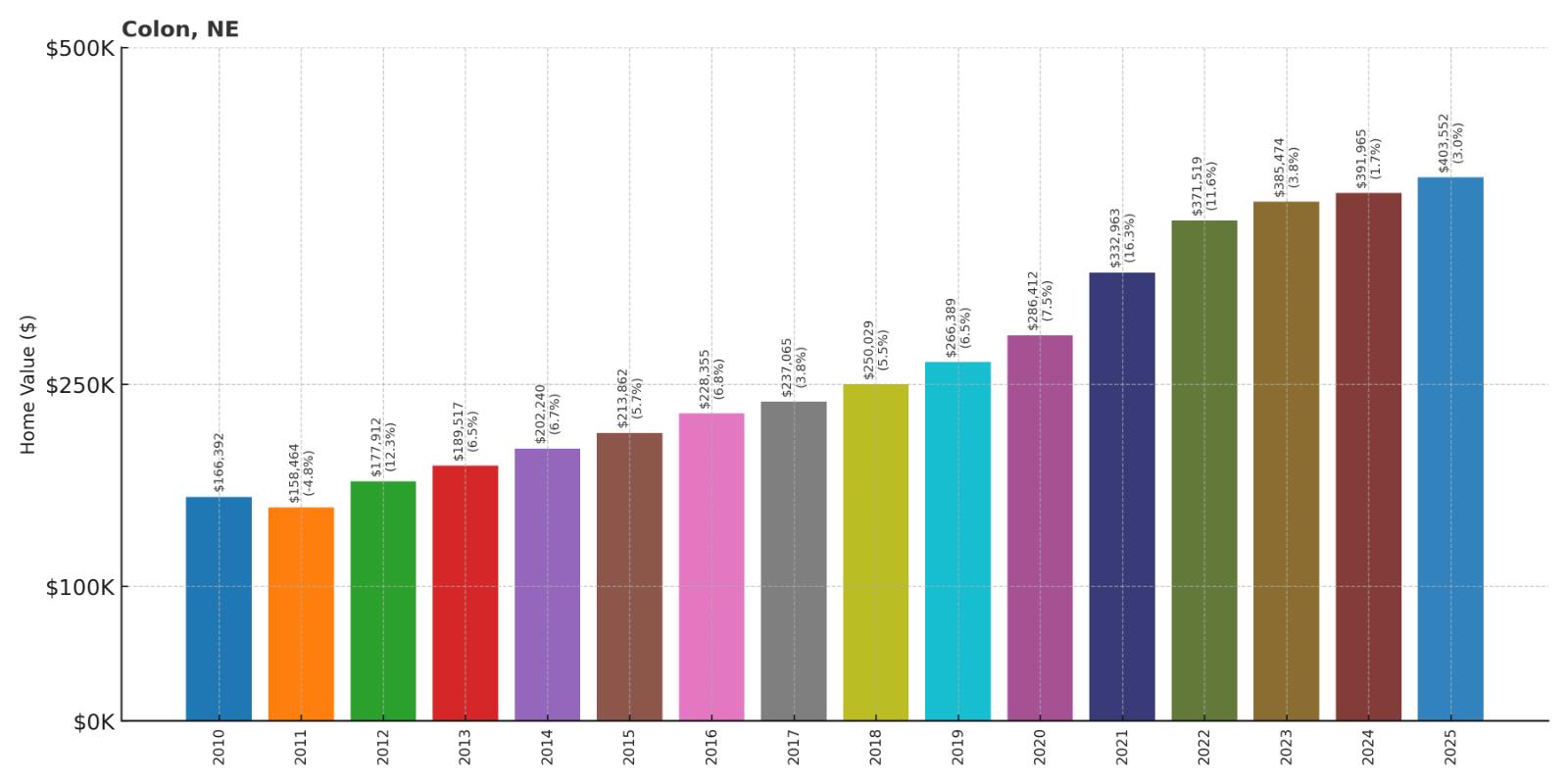
- 2010: $166,392
- 2011: $158,464
- 2012: $177,912
- 2013: $189,517
- 2014: $202,240
- 2015: $213,862
- 2016: $228,355
- 2017: $237,065
- 2018: $250,029
- 2019: $266,389
- 2020: $286,412
- 2021: $332,963
- 2022: $371,519
- 2023: $385,474
- 2024: $391,965
- 2025: $403,552
Colon has delivered strong appreciation over the past 15 years, with home values increasing by 143% since 2010. The community showed steady growth throughout the decade, with acceleration during the pandemic years pushing values above $400,000. This consistent upward trend reflects the town’s appeal as an affordable rural community with good access to larger employment centers.
Why Colon?
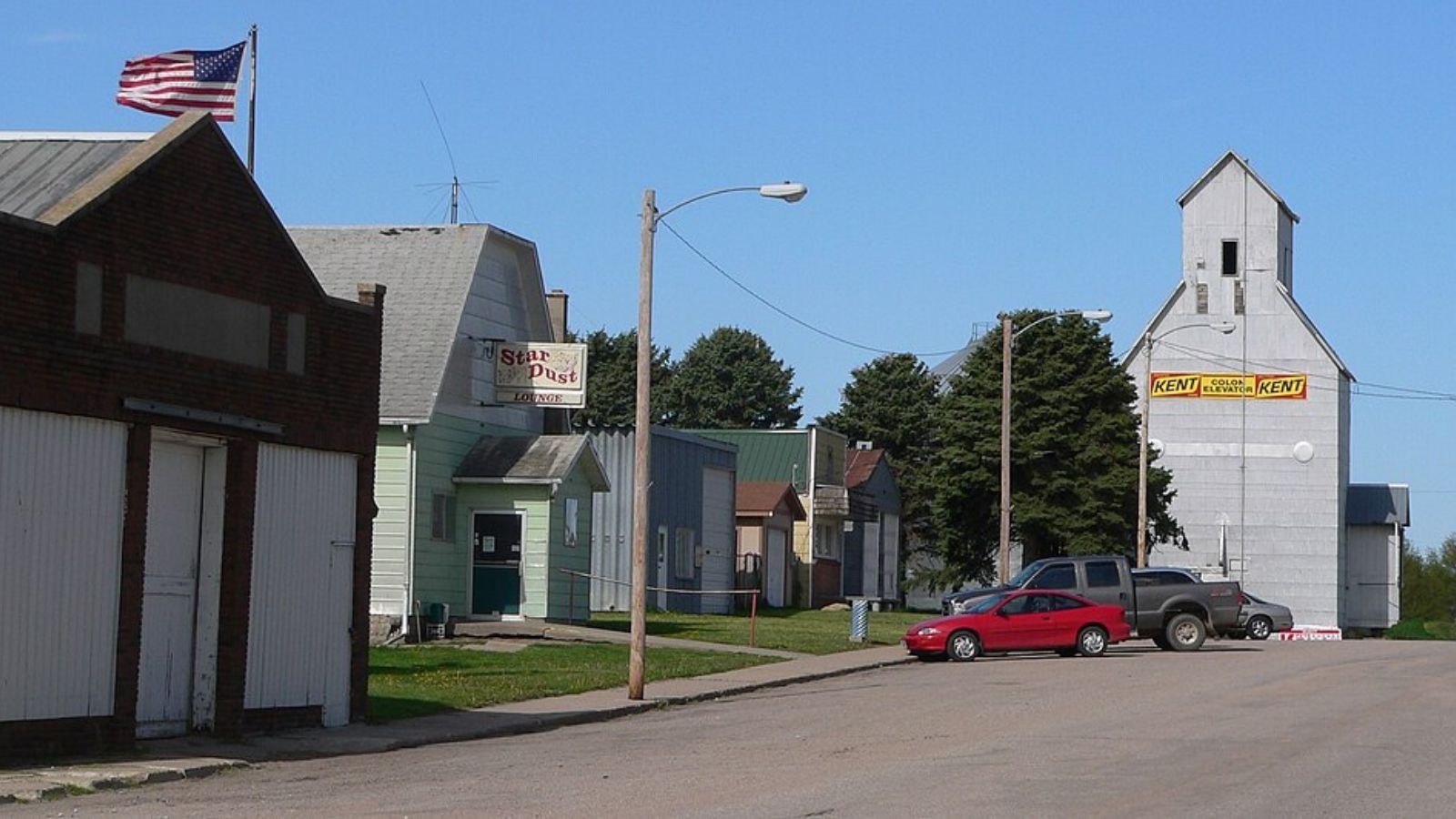
Why are people willing to pay so much to live here? What’s special about it?
Colon attracts residents with its quiet rural atmosphere and strategic location in eastern Nebraska’s Saunders County. The community offers affordable living costs and property taxes while maintaining access to Omaha and Lincoln employment markets within reasonable commuting distance. Families appreciate the safe environment, friendly neighbors, and strong sense of community that small towns provide.
The town’s agricultural setting provides scenic beauty and outdoor recreational opportunities that urban areas cannot match. Local amenities include community centers, parks, and small businesses that meet daily needs while preserving the area’s authentic character. Colon’s combination of rural charm and practical location appeals to both young families starting out and retirees seeking peaceful living environments.
How Colon Rose to Prominence
Established in the late 1800s during Nebraska’s agricultural expansion, Colon developed as a service center for surrounding farms and ranches. The community grew around grain elevators and farm implement dealers that served the local agricultural economy. Railroad connections provided essential transportation links for shipping crops and receiving supplies from regional markets.
Modern growth stems from the community’s affordability and rural lifestyle appeal, particularly as urban housing costs have risen. The town’s location within driving distance of both Omaha and Lincoln makes it attractive to commuters seeking lower housing costs and more space. Investment in community infrastructure and maintaining local services has helped Colon remain viable and appealing to new residents seeking authentic small-town living experiences.
3 Interesting Tidbits
1. Agricultural Center – Historic grain elevators still serve local farmers, maintaining the town’s role in regional agricultural commerce.
2. Community Events – Annual celebrations bring together residents and neighboring communities for festivals that highlight local heritage and traditions.
3. Natural Setting – The town’s location among rolling agricultural fields provides excellent opportunities for hunting, fishing, and outdoor recreation.
24. Morse Bluff – 119% Home Price Increase Since 2010
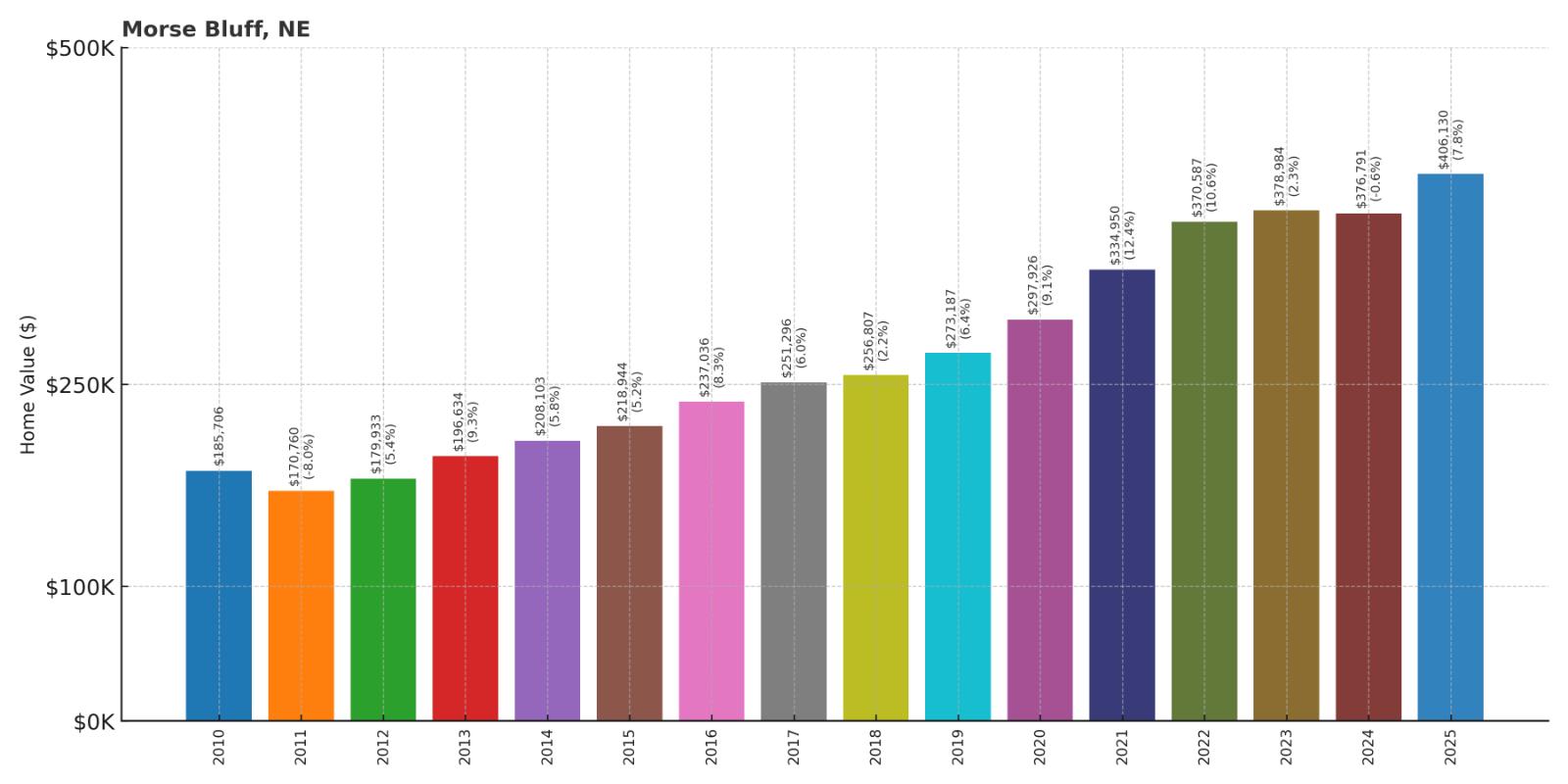
- 2010: $185,706
- 2011: $170,760
- 2012: $179,933
- 2013: $196,634
- 2014: $208,103
- 2015: $218,944
- 2016: $237,036
- 2017: $251,296
- 2018: $256,807
- 2019: $273,187
- 2020: $297,926
- 2021: $334,950
- 2022: $370,587
- 2023: $378,984
- 2024: $376,791
- 2025: $406,130
Morse Bluff has shown impressive appreciation since 2010, with home values more than doubling over 15 years. After initial volatility in the early 2010s, the community established consistent upward momentum that peaked during the pandemic housing boom. The recent 2025 surge demonstrates continued strong demand for this small Saunders County community.
Why Morse Bluff?

Why are people willing to pay so much to live here? What’s special about it?
Morse Bluff offers residents a unique combination of historic charm and rural tranquility in eastern Nebraska. The community sits along the Platte River, providing scenic beauty and recreational opportunities that appeal to outdoor enthusiasts. Families value the safe environment, friendly neighbors, and authentic small-town atmosphere that creates strong community bonds.
The town’s location provides reasonable access to Fremont and Omaha employment centers while maintaining lower living costs and rural lifestyle benefits. Historic buildings and tree-lined streets create an attractive residential environment that appeals to buyers seeking character and charm. Morse Bluff’s riverside setting and agricultural surroundings offer recreational opportunities and scenic beauty that urban areas cannot provide.
How Morse Bluff Rose to Prominence
Founded in the 1860s along the Platte River, Morse Bluff developed as a river crossing point and trading post during Nebraska’s territorial period. The community grew as a transportation hub, serving travelers and freighters moving west along the Platte River valley. Railroad development in the 1880s further enhanced the town’s role as a regional service center.
The town’s historic significance and scenic riverfront location have attracted buyers interested in both heritage and natural beauty. Modern growth reflects increased demand for rural properties with character and outdoor amenities, particularly among buyers priced out of larger metro areas. The community’s commitment to preserving its historic character while accommodating new residents has created a unique appeal that drives steady appreciation in home values.
3 Interesting Tidbits
1. Historic Settlement – One of Nebraska’s oldest communities, Morse Bluff features buildings and sites dating to the territorial period of the 1860s.
2. River Recreation – The Platte River provides fishing, boating, and wildlife viewing opportunities right in the community’s backyard.
3. Pioneer Heritage – The town played a role in westward migration, serving as a crossing point for settlers heading to Colorado and California.
23. Hallam – 100% Home Price Increase Since 2010

- 2010: $203,020
- 2011: $196,414
- 2012: $196,214
- 2013: $205,008
- 2014: $213,360
- 2015: $221,342
- 2016: $236,517
- 2017: $252,454
- 2018: $272,735
- 2019: $279,855
- 2020: $297,842
- 2021: $345,532
- 2022: $392,243
- 2023: $397,432
- 2024: $401,355
- 2025: $406,784
Hallam achieved a perfect 100% increase in home values since 2010, doubling from just over $203,000 to more than $406,000. The community showed steady appreciation throughout the 2010s, with significant acceleration during the pandemic years. This consistent growth pattern reflects Hallam’s position as a desirable small community within Lincoln’s expanding metropolitan area.
Why Hallam?
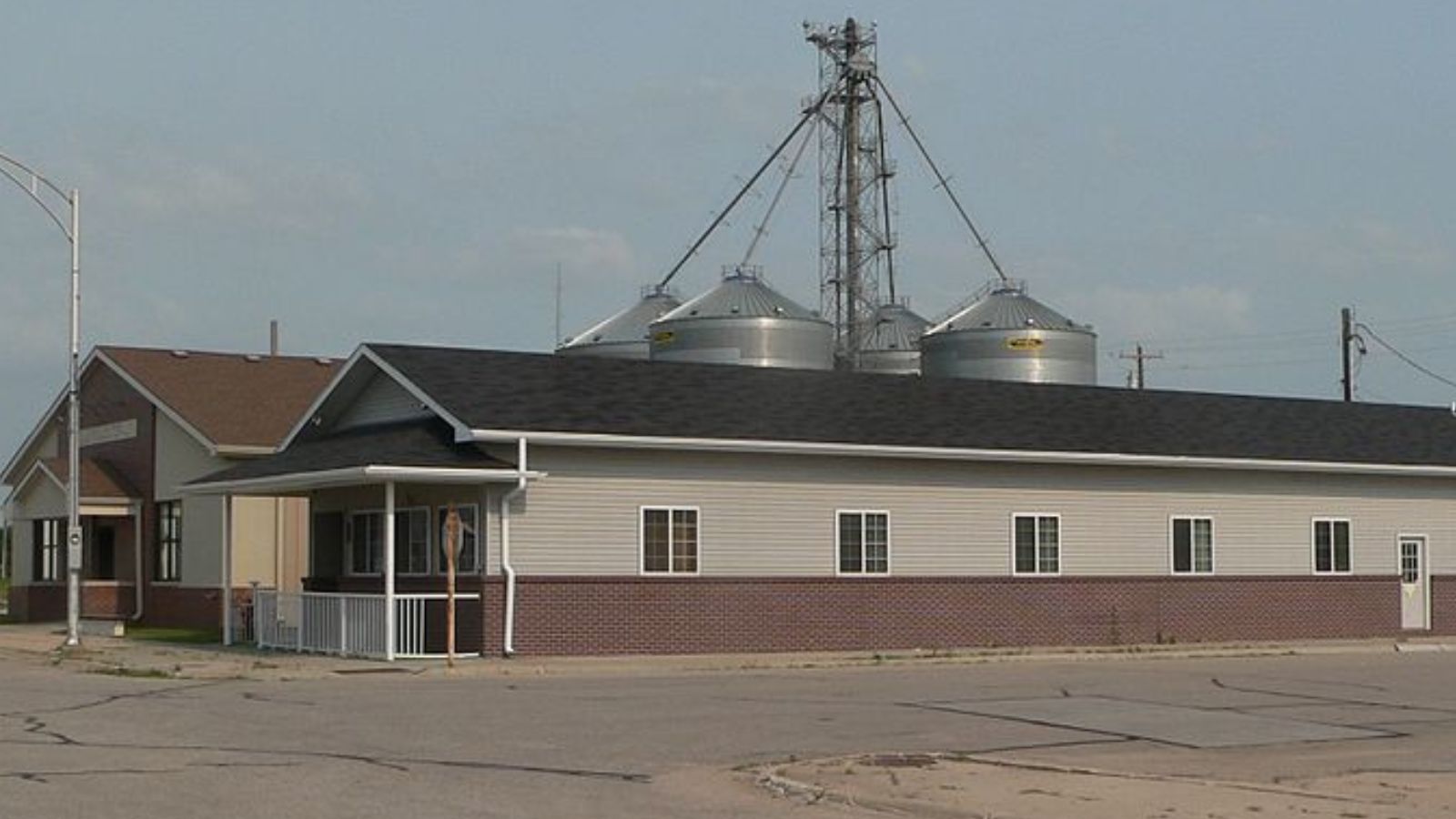
Why are people willing to pay so much to live here? What’s special about it?
Hallam attracts residents with its rural charm and convenient proximity to Lincoln, located just south of the capital city in Lancaster County. Families are drawn to the excellent Norris School District, which consistently ranks among Nebraska’s top educational systems for academic achievement and extracurricular programs. The community offers a safe, family-oriented environment with strong neighborhood connections.
The town features large residential lots and newer housing developments that provide space and privacy not available in urban settings. Local parks and recreational facilities support active lifestyles, while the agricultural setting offers scenic beauty and outdoor opportunities. Hallam’s location allows residents to enjoy small-town living while maintaining easy access to Lincoln’s employment opportunities and urban amenities.
How Hallam Rose to Prominence
Originally established as a railroad town in the 1880s, Hallam developed around agricultural activities and transportation services. The community remained relatively stable through most of the 20th century, serving local farming operations while maintaining its small-town character. Its proximity to Lincoln provided some employment diversity beyond agriculture.
Growth accelerated as Lincoln’s metropolitan area expanded southward, bringing suburban development to previously rural areas. Hallam’s excellent school district became a major attraction for families, while the community’s rural setting appealed to those seeking more space and lower costs than urban areas provide. New residential developments and infrastructure improvements have supported steady growth while preserving the town’s agricultural heritage and small-town atmosphere.
3 Interesting Tidbits
1. Educational Excellence – Hallam is served by the highly-rated Norris School District, known for academic achievement and successful college preparation programs.
2. Agricultural Heritage – Original grain storage facilities still operate in the community, connecting modern residents to the area’s farming roots.
3. Community Pride – Annual festivals and community events bring together residents and strengthen the social fabric of this close-knit town.
22. Papillion – 85% Home Price Increase Since 2010
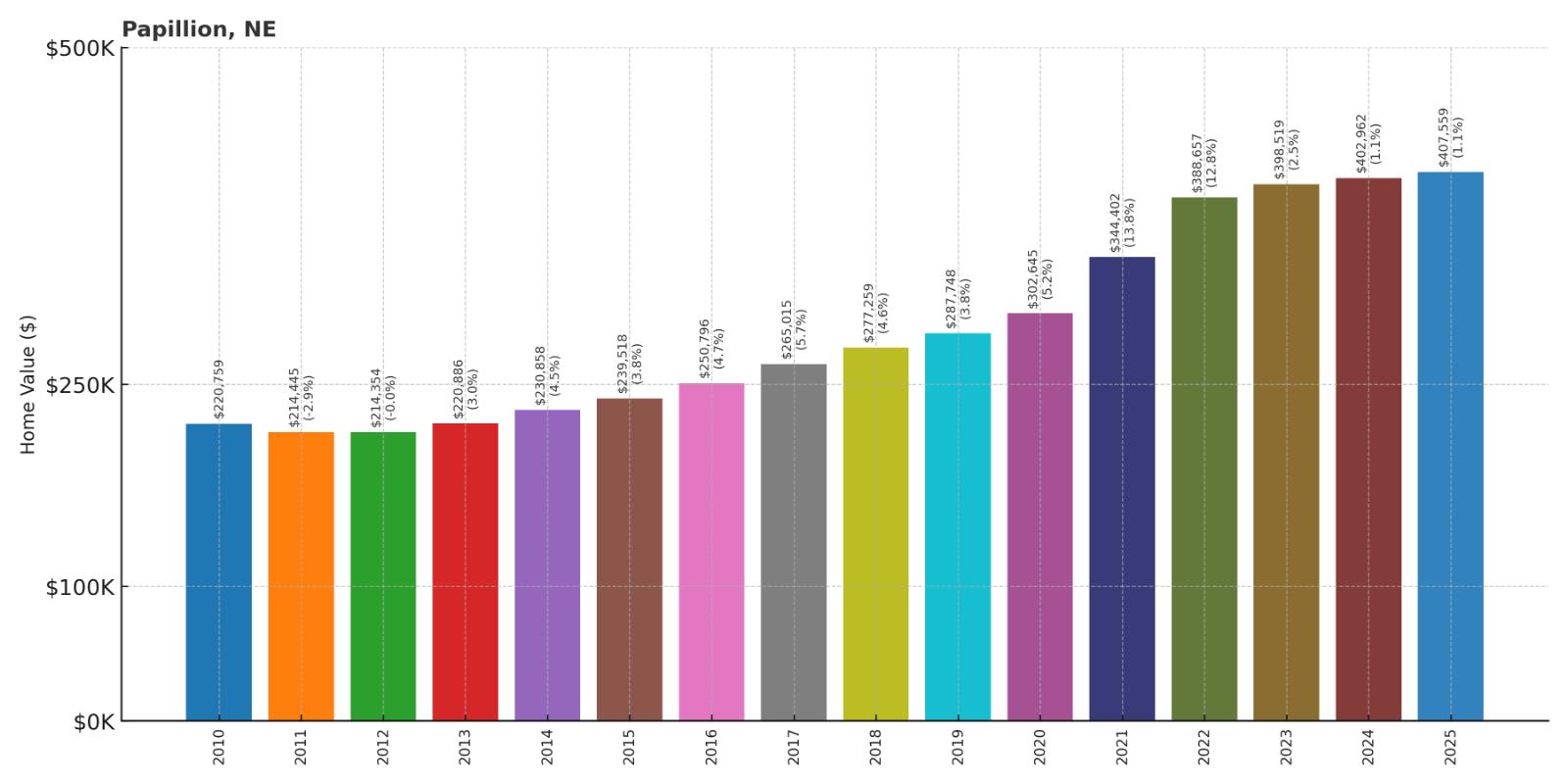
- 2010: $220,759
- 2011: $214,445
- 2012: $214,354
- 2013: $220,886
- 2014: $230,858
- 2015: $239,518
- 2016: $250,796
- 2017: $265,015
- 2018: $277,259
- 2019: $287,748
- 2020: $302,645
- 2021: $344,402
- 2022: $388,657
- 2023: $398,519
- 2024: $402,962
- 2025: $407,559
Papillion has demonstrated solid appreciation since 2010, with home values climbing 85% over 15 years. As one of the larger communities on our list, the city showed steady growth throughout the decade, with acceleration during the pandemic years. This consistent upward trend reflects Papillion’s position as a desirable suburb in the Omaha metropolitan area with excellent amenities and schools.
Why Papillion?
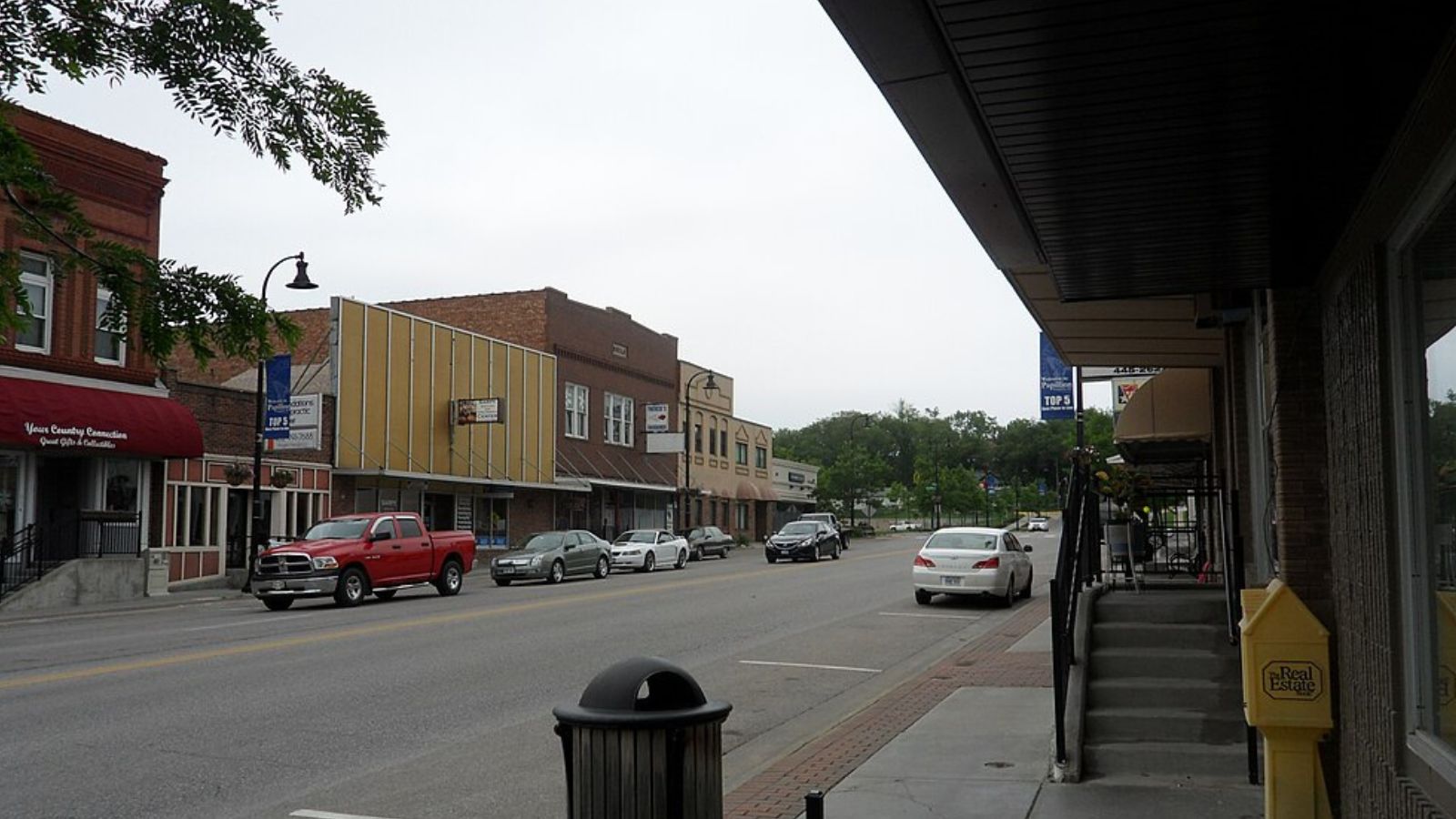
Why are people willing to pay so much to live here? What’s special about it?
Papillion stands out as one of Nebraska’s premier suburban communities, offering residents top-rated schools in the Papillion La Vista Community Schools district. Families are drawn to the city’s excellent parks and recreation system, including numerous trails, sports complexes, and community centers that support active lifestyles. The community successfully balances suburban amenities with small-town charm and accessibility.
The city’s location in Sarpy County provides convenient access to Omaha employment centers while maintaining lower crime rates and better schools than many urban areas. Papillion features well-planned neighborhoods, quality shopping and dining options, and cultural amenities that appeal to professionals and families. The combination of excellent schools, safe neighborhoods, and comprehensive city services creates a high quality of life that justifies premium home prices.
How Papillion Rose to Prominence
Founded in the 1870s along Papillion Creek, the community initially developed as a mill town and agricultural service center. The town grew steadily through the early 1900s, supported by railroad connections and its role as a county seat. For much of the 20th century, Papillion remained a modest farming community with some suburban development as Omaha expanded.
Rapid growth began in the 1980s and 1990s as Omaha’s suburban expansion reached Sarpy County, bringing new residential developments and commercial growth. The city invested heavily in schools, parks, and infrastructure to support this growth while maintaining high quality standards. Papillion’s commitment to planned development, excellent public services, and community amenities has established it as one of the most desirable places to live in the Omaha metropolitan area.
3 Interesting Tidbits
1. Days of Old – The annual Papillion Days festival celebrates the city’s heritage with parades, live entertainment, and community activities that draw thousands of visitors.
2. Trail System – The city maintains over 30 miles of recreational trails connecting neighborhoods, parks, and commercial areas for walking, biking, and jogging.
3. Economic Hub – Papillion serves as a regional business center with corporate headquarters and major employers that support the local economy.
21. Adams – 144% Home Price Increase Since 2010
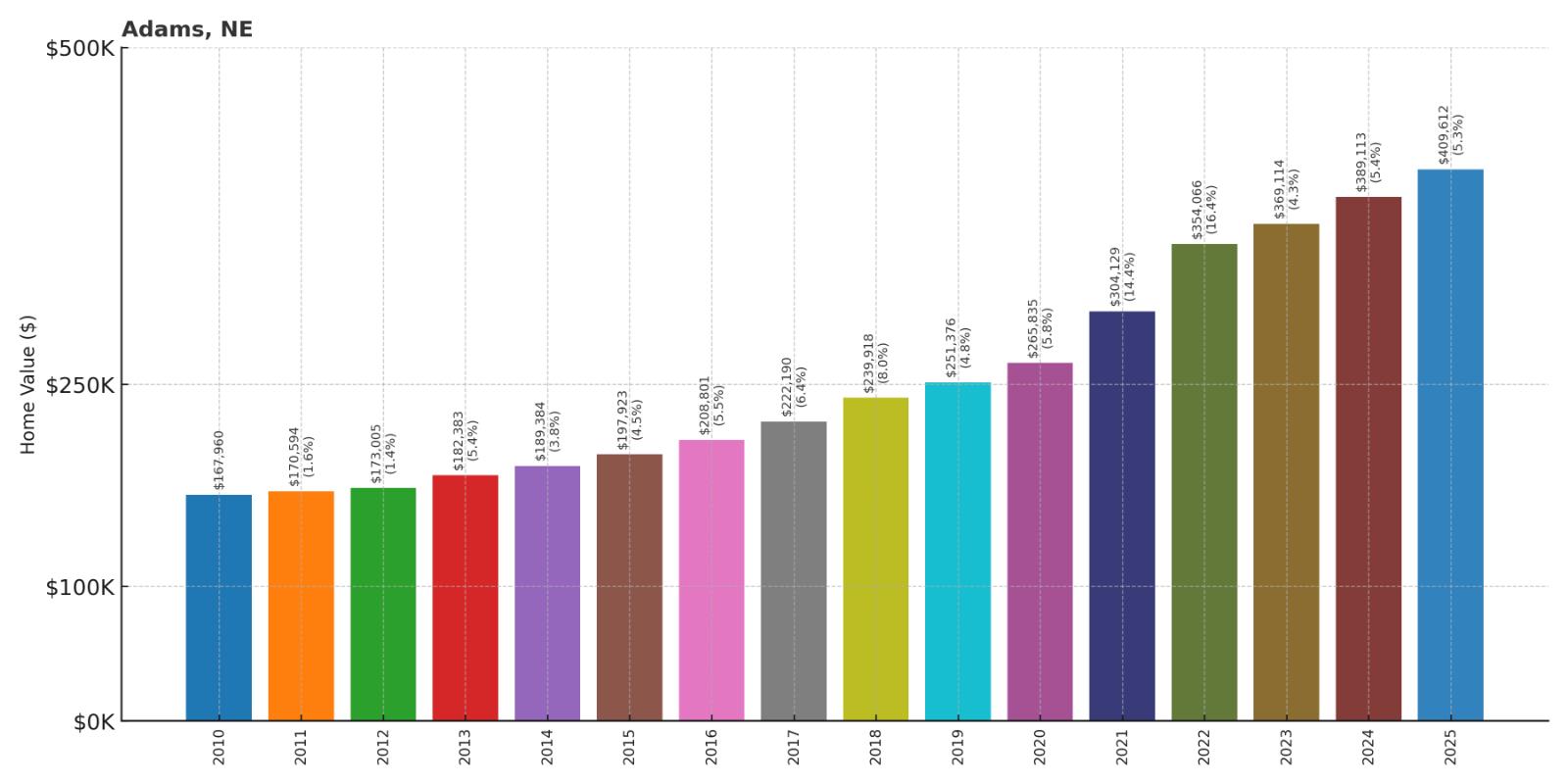
- 2010: $167,960
- 2011: $170,594
- 2012: $173,005
- 2013: $182,383
- 2014: $189,384
- 2015: $197,923
- 2016: $208,801
- 2017: $222,190
- 2018: $239,918
- 2019: $251,376
- 2020: $265,835
- 2021: $304,129
- 2022: $354,066
- 2023: $369,114
- 2024: $389,113
- 2025: $409,612
Adams has shown exceptional growth with a 144% increase in home values since 2010, climbing from under $168,000 to over $409,000. The community demonstrated steady appreciation throughout the 2010s, with significant acceleration during and after the pandemic. This strong performance reflects Adams’ appeal as an affordable small town within commuting distance of Lincoln.
Why Adams?
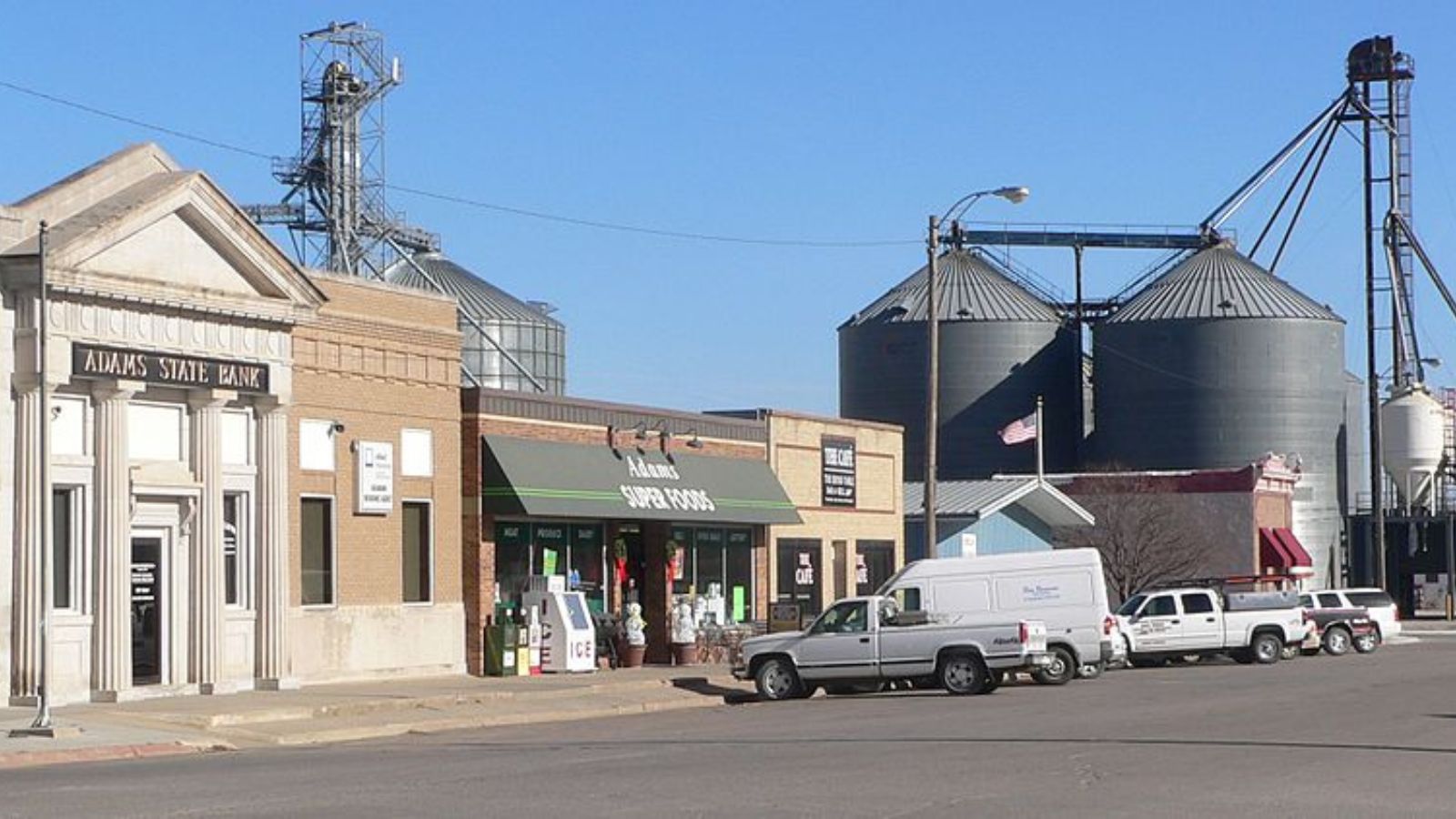
Why are people willing to pay so much to live here? What’s special about it?
Adams attracts residents with its small-town atmosphere and convenient location about 25 miles southeast of Lincoln in Gage County. The community offers affordable living costs and property taxes while maintaining access to larger employment markets within reasonable commuting distance. Families appreciate the safe environment, quality local schools, and strong community connections that small towns uniquely provide.
The town’s rural setting features agricultural surroundings that provide scenic beauty and outdoor recreational opportunities. Local amenities include community centers, parks, and essential services that meet daily needs while preserving authentic small-town character. Adams’ combination of affordability, rural charm, and practical location appeals to both young families and retirees seeking peaceful living environments.
How Adams Rose to Prominence
Established in the 1880s during Nebraska’s railroad expansion, Adams developed as an agricultural service center for surrounding farms and ranches. The community grew around grain elevators, farm implement dealers, and other businesses serving the local agricultural economy. Railroad connections provided essential transportation links for shipping crops and receiving supplies from regional markets.
Modern appreciation reflects the community’s affordability and rural lifestyle appeal, particularly as urban housing costs have risen significantly. The town’s location within driving distance of Lincoln makes it attractive to commuters seeking lower housing costs and more space than urban areas provide. Investment in community infrastructure and maintaining local services has helped Adams remain viable and appealing to new residents seeking authentic small-town living experiences.
3 Interesting Tidbits
1. Agricultural Legacy – Historic grain storage facilities continue to serve local farmers, maintaining the town’s connection to its agricultural heritage.
2. Community Events – Annual festivals bring together residents and neighboring communities for celebrations that highlight local traditions and foster social connections.
3. Rural Recreation – The surrounding countryside provides excellent opportunities for hunting, fishing, and outdoor activities that attract nature enthusiasts.
20. Herman – 157% Home Price Increase Since 2010
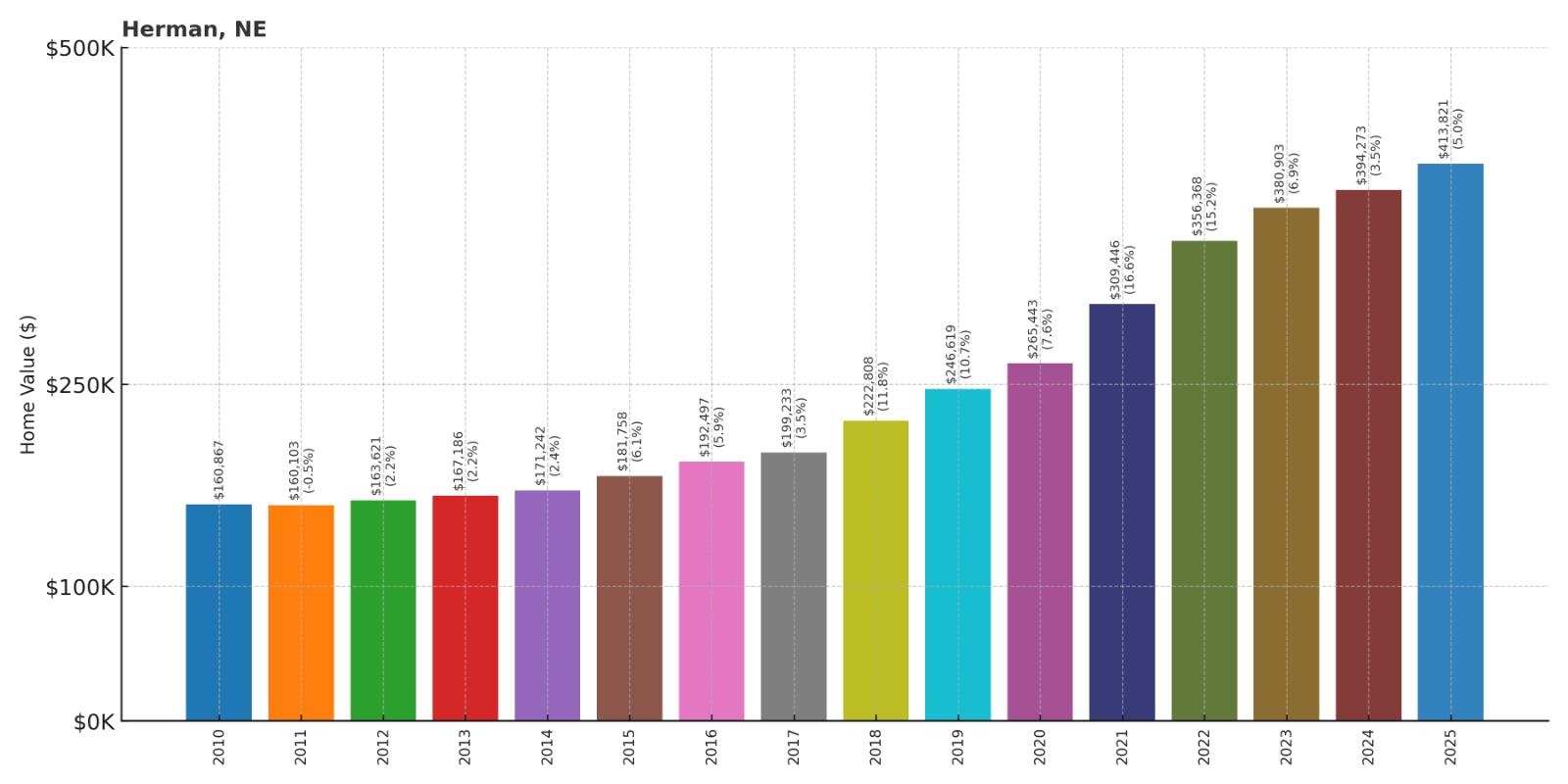
- 2010: $160,867
- 2011: $160,103
- 2012: $163,621
- 2013: $167,186
- 2014: $171,242
- 2015: $181,758
- 2016: $192,497
- 2017: $199,233
- 2018: $222,808
- 2019: $246,619
- 2020: $265,443
- 2021: $309,446
- 2022: $356,368
- 2023: $380,903
- 2024: $394,273
- 2025: $413,821
Herman has achieved remarkable appreciation with a 157% increase in home values since 2010, rising from approximately $161,000 to over $413,000. The community showed gradual growth through most of the 2010s, then experienced significant acceleration starting in 2018 and continuing through the pandemic years. This strong performance reflects growing recognition of Herman’s value proposition in Washington County.
Why Herman?
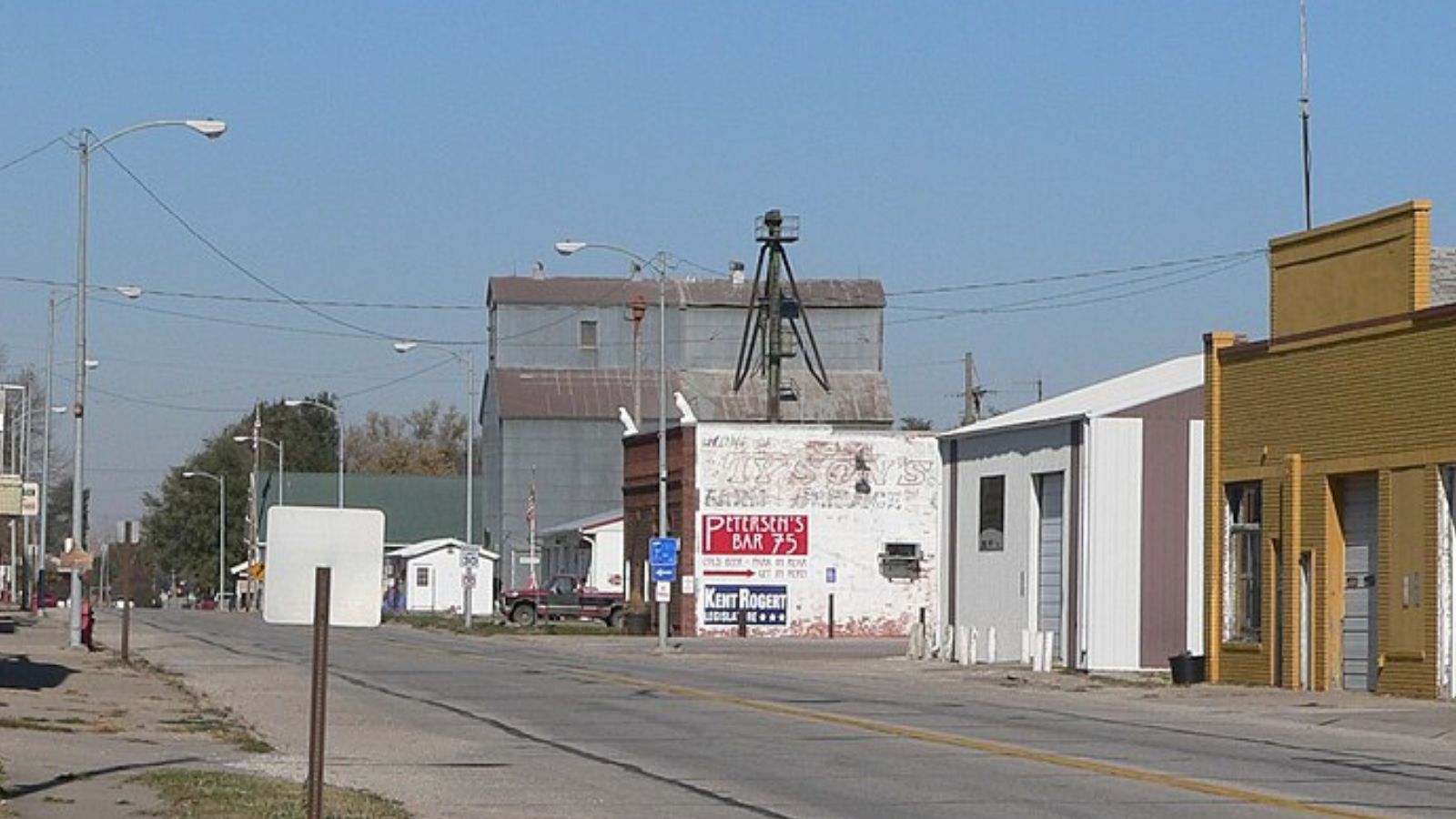
Why are people willing to pay so much to live here? What’s special about it?
Herman offers residents a peaceful rural lifestyle in eastern Nebraska’s Washington County with convenient access to Omaha employment opportunities. The community attracts families and individuals seeking affordable housing, low crime rates, and friendly neighbors in an authentic small-town setting. Local amenities include parks, community facilities, and essential services that support daily life.
The town’s agricultural surroundings provide scenic beauty and recreational opportunities that urban areas cannot match. Property values remain reasonable compared to suburban areas closer to Omaha, making Herman attractive to first-time buyers and those seeking more space for their money. The community’s commitment to maintaining its rural character while accommodating new residents creates an appealing balance for buyers seeking small-town living.
How Herman Rose to Prominence
Founded in the 1880s during Nebraska’s agricultural expansion, Herman developed as a service center for surrounding farms and the growing German immigrant population in the area. The community’s name reflects its German heritage, as many early settlers came from Germany seeking agricultural opportunities in the American Midwest. Railroad connections supported local agricultural commerce and community growth.
Recent growth stems from the community’s affordability and rural appeal, particularly among buyers priced out of closer-in Omaha suburbs. The town’s location provides reasonable commuting access to metropolitan employment while offering lower housing costs and rural lifestyle benefits. Investment in community infrastructure and preservation of local services has helped Herman remain attractive to new residents seeking authentic small-town experiences.
3 Interesting Tidbits
1. German Heritage – The community’s name and cultural traditions reflect the significant German immigrant population that settled the area in the late 1800s.
2. Agricultural Center – Historic grain elevators and farm service businesses continue to serve the local agricultural economy, maintaining economic diversity.
3. Community Spirit – Annual events and volunteer organizations create strong social bonds among residents and preserve small-town traditions.
19. Bennington – 80% Home Price Increase Since 2010

- 2010: $230,907
- 2011: $219,539
- 2012: $218,629
- 2013: $226,838
- 2014: $236,434
- 2015: $248,112
- 2016: $259,766
- 2017: $271,040
- 2018: $286,200
- 2019: $291,769
- 2020: $309,228
- 2021: $356,933
- 2022: $406,618
- 2023: $408,983
- 2024: $412,023
- 2025: $414,975
Bennington has shown solid appreciation with an 80% increase in home values since 2010, climbing from approximately $231,000 to nearly $415,000. The community demonstrated steady growth throughout the decade, with significant acceleration during the pandemic years. As a larger suburb in the Omaha metropolitan area, Bennington’s growth reflects its appeal as an established community with excellent amenities and schools.
Why Bennington?

Why are people willing to pay so much to live here? What’s special about it?
Bennington attracts residents as one of Douglas County’s most desirable suburban communities, offering excellent schools in the Bennington Public Schools district. Families are drawn to the city’s comprehensive parks and recreation system, including sports complexes, trails, and community facilities that support active lifestyles. The community successfully maintains small-town charm while providing suburban conveniences and amenities.
The city’s location provides convenient access to Omaha employment centers while offering lower density living and better schools than many urban areas. Bennington features well-established neighborhoods, quality local businesses, and cultural amenities that appeal to professionals and families. The combination of excellent schools, safe neighborhoods, and comprehensive city services creates a high quality of life that supports strong property values.
How Bennington Rose to Prominence
Founded in the 1860s as a farming community, Bennington developed around agricultural activities and early railroad connections. The town grew steadily through the early 1900s, serving local farms while maintaining its rural character. For much of the 20th century, Bennington remained a modest agricultural community with some suburban development as Omaha expanded northward.
Significant growth began in the 1980s and accelerated through the 2000s as Omaha’s suburban expansion reached Douglas County, bringing new residential developments and population growth. The city invested in schools, parks, and infrastructure to support this growth while maintaining community character. Bennington’s commitment to quality development standards, excellent public services, and community amenities has established it as one of the most desirable places to live in the Omaha area.
3 Interesting Tidbits
1. Days Celebration – The annual Bennington Days festival features parades, live entertainment, and community activities that celebrate local heritage and bring residents together.
2. Recreation Hub – The city operates multiple parks, sports complexes, and recreational facilities that serve both residents and regional visitors.
3. Historic Downtown – The community maintains a charming downtown district with local businesses, restaurants, and services that preserve small-town character.
18. Kennard – 129% Home Price Increase Since 2010
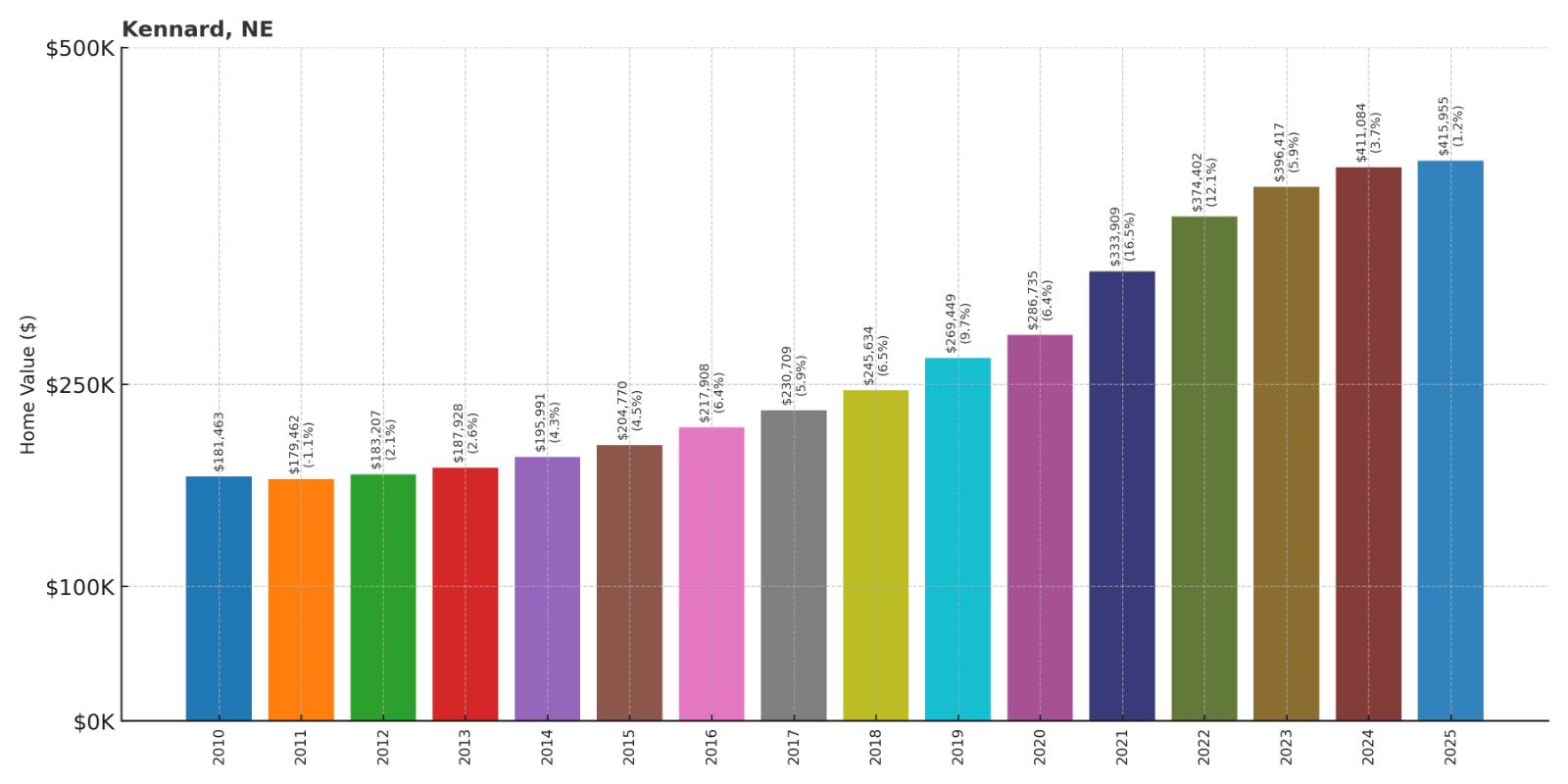
- 2010: $181,463
- 2011: $179,462
- 2012: $183,207
- 2013: $187,928
- 2014: $195,991
- 2015: $204,770
- 2016: $217,908
- 2017: $230,709
- 2018: $245,634
- 2019: $269,449
- 2020: $286,735
- 2021: $333,909
- 2022: $374,402
- 2023: $396,417
- 2024: $411,084
- 2025: $415,955
Kennard has delivered impressive growth with a 129% increase in home values since 2010, rising from approximately $181,000 to nearly $416,000. The community showed consistent appreciation throughout the 2010s, with significant acceleration after 2019. This strong performance reflects Kennard’s growing appeal as an affordable rural community within reasonable commuting distance of Omaha.
Why Kennard?

Why are people willing to pay so much to live here? What’s special about it?
Kennard offers residents rural living in Washington County with convenient access to Omaha, located about 30 minutes northwest of the metropolitan area. The community attracts buyers seeking peaceful small-town life, affordable housing, and friendly neighbors in an authentic rural setting. Families appreciate the safe environment and strong community connections that small towns uniquely provide.
The town’s agricultural surroundings provide scenic beauty and outdoor recreational opportunities that appeal to those seeking escape from urban congestion. Property values remain reasonable compared to closer-in suburbs, making Kennard attractive to first-time buyers and those wanting more space for their investment. The community’s rural character and growing recognition as a viable commuter option have driven steady appreciation in recent years.
How Kennard Rose to Prominence
Established in the late 1800s during Nebraska’s agricultural expansion, Kennard developed as a service center for surrounding farms and ranches in Washington County. The community grew around agricultural businesses and maintained its rural character through most of the 20th century. Railroad and highway connections provided essential transportation links for local commerce and resident mobility.
Recent growth reflects increased demand for rural properties with commuter access to urban employment, accelerated by remote work trends and urban housing costs. The town’s location provides reasonable access to Omaha while offering lower housing costs and rural lifestyle benefits that many buyers find appealing. Investment in community infrastructure and services has helped Kennard remain attractive to new residents seeking authentic small-town living experiences.
3 Interesting Tidbits
1. Agricultural Heritage – Historic farm buildings and grain storage facilities throughout the area reflect the community’s deep agricultural roots and continuing farming operations.
2. Community Events – Annual festivals and gatherings bring together residents and strengthen social bonds in this close-knit rural community.
3. Natural Setting – The town’s location among rolling farmland provides excellent opportunities for hunting, fishing, and outdoor recreation.
17. Elwood – 169% Home Price Increase Since 2010
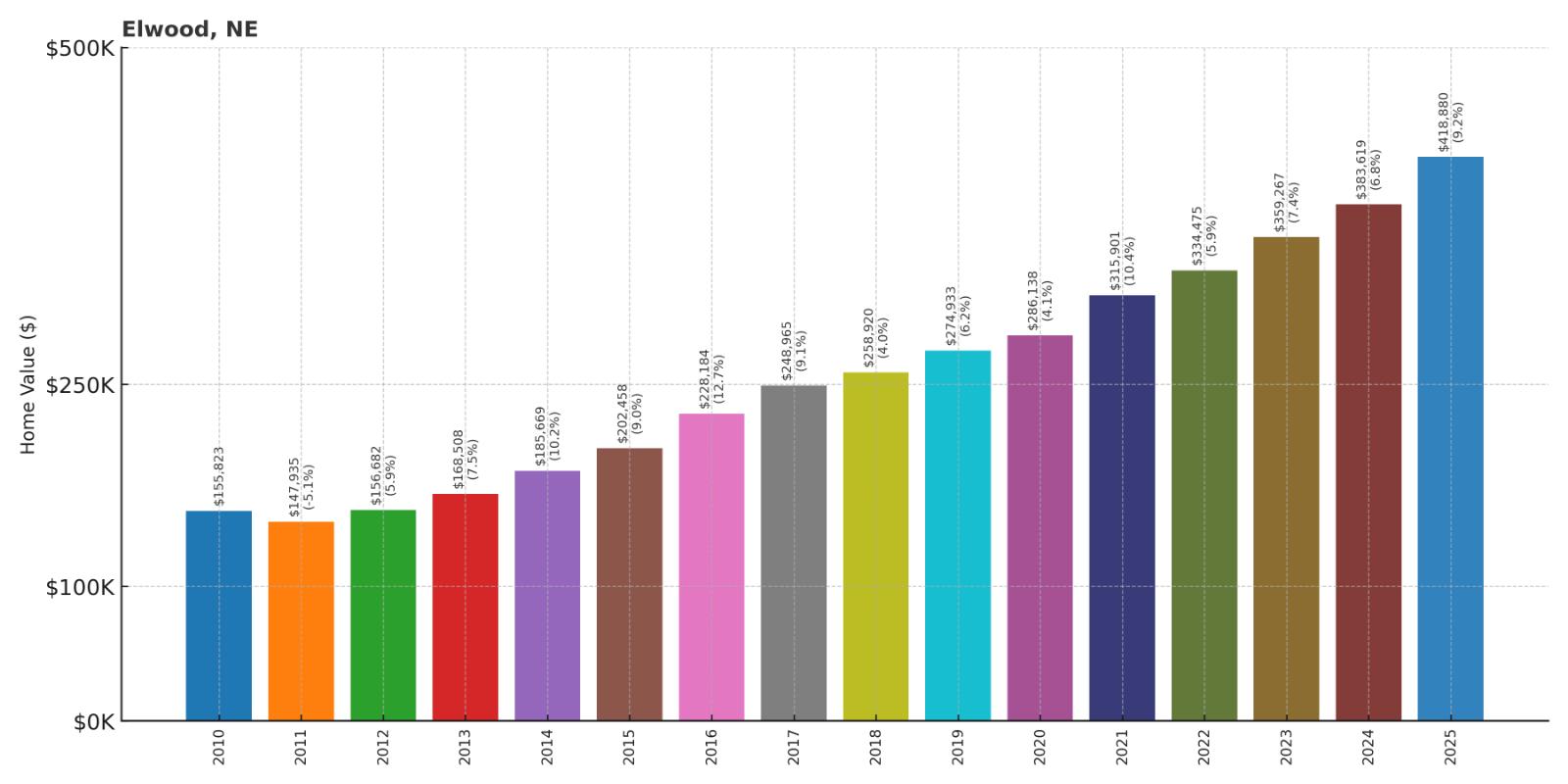
- 2010: $155,823
- 2011: $147,935
- 2012: $156,682
- 2013: $168,508
- 2014: $185,669
- 2015: $202,458
- 2016: $228,184
- 2017: $248,965
- 2018: $258,920
- 2019: $274,933
- 2020: $286,138
- 2021: $315,901
- 2022: $334,475
- 2023: $359,267
- 2024: $383,619
- 2025: $418,880
Elwood has achieved exceptional appreciation with a 169% increase in home values since 2010, climbing from approximately $156,000 to nearly $419,000. The community showed strong growth throughout the decade, with particularly impressive gains between 2014 and 2017. This remarkable performance reflects growing recognition of Elwood’s value proposition in south-central Nebraska’s Gosper County.
Why Elwood?
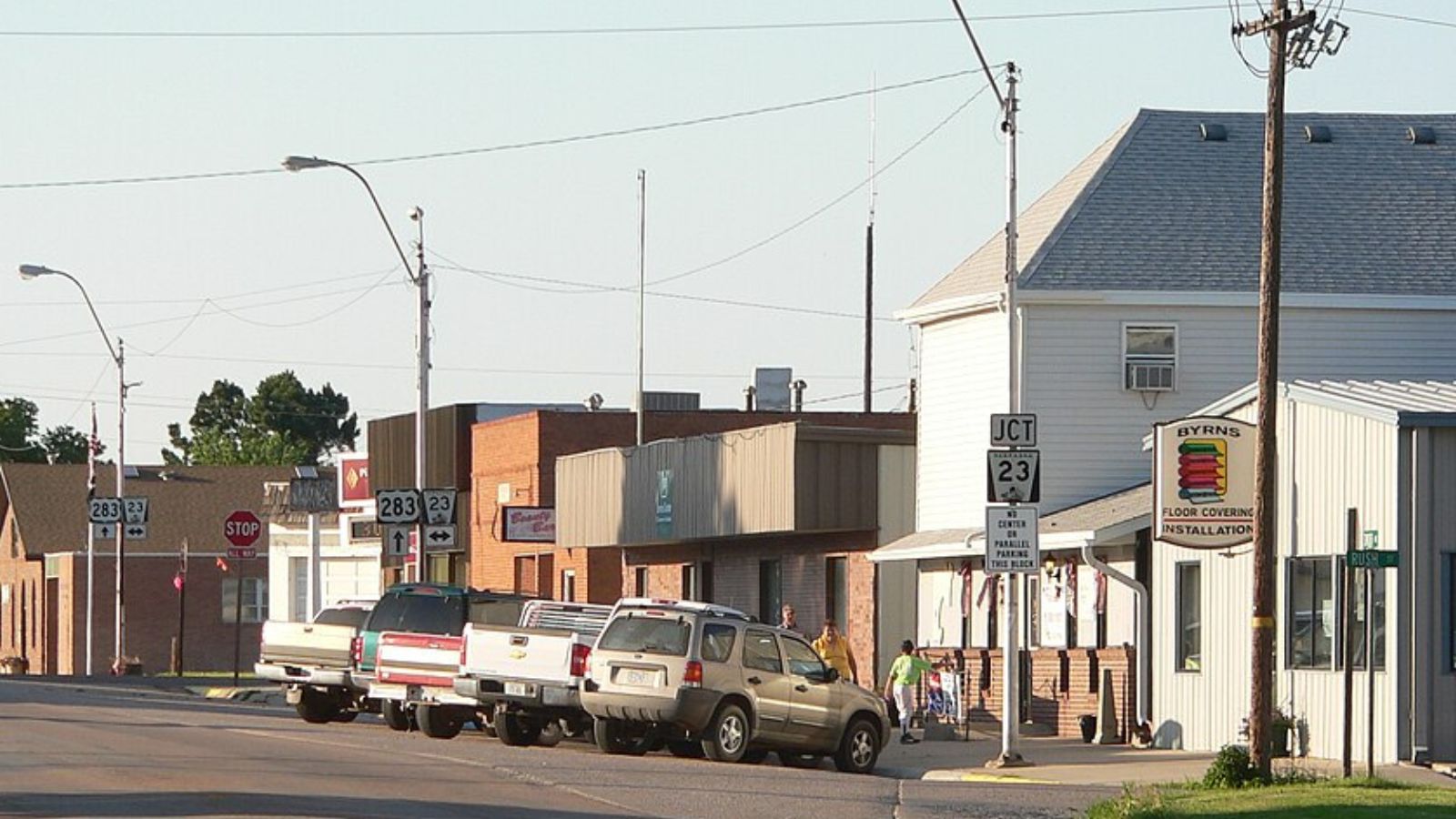
Why are people willing to pay so much to live here? What’s special about it?
Elwood attracts residents with its peaceful rural atmosphere in south-central Nebraska’s agricultural heartland. The community offers affordable living costs, friendly neighbors, and a slower pace of life that appeals to families and retirees seeking authentic small-town experiences. Local amenities include parks, community facilities, and essential services that support comfortable rural living.
The town’s agricultural surroundings provide scenic beauty and outdoor recreational opportunities that urban areas cannot match. Property values remain attractive compared to more populated areas, making Elwood appealing to buyers seeking value and space. The community’s commitment to maintaining its rural character while accommodating new residents creates a welcoming environment for those seeking genuine small-town living.
How Elwood Rose to Prominence
Founded in the late 1800s during Nebraska’s westward agricultural expansion, Elwood developed as a service center for surrounding farms and ranches in Gosper County. The community grew around grain elevators, farm implement dealers, and other businesses serving the local agricultural economy. Railroad connections provided vital transportation links for shipping crops and receiving supplies.
The dramatic price appreciation reflects several factors: very low starting values, increased demand for rural properties during the pandemic, and growing recognition of small towns as viable living options. Remote work opportunities have made communities like Elwood more attractive to professionals, while the town’s affordability appeals to buyers seeking value. Investment in local infrastructure and community amenities has supported this growth trajectory.
3 Interesting Tidbits
1. Agricultural Center – Historic grain storage and processing facilities continue to serve local farmers, maintaining the town’s role in regional agriculture.
2. Prairie Setting – The community sits in prime farming country with vast agricultural fields extending in all directions, providing scenic rural views.
3. Community Pride – Annual events and volunteer organizations create strong social connections among residents and preserve small-town traditions.
16. Gretna – 89% Home Price Increase Since 2010

- 2010: $225,609
- 2011: $219,819
- 2012: $222,872
- 2013: $235,010
- 2014: $248,581
- 2015: $259,447
- 2016: $270,196
- 2017: $282,102
- 2018: $299,130
- 2019: $306,823
- 2020: $321,727
- 2021: $365,833
- 2022: $417,446
- 2023: $420,986
- 2024: $426,134
- 2025: $426,200
Gretna has shown strong appreciation with an 89% increase in home values since 2010, climbing from approximately $226,000 to over $426,000. As one of the larger communities on our list, Gretna demonstrated steady growth throughout the decade, with significant acceleration during the pandemic years. This consistent performance reflects the city’s position as a premier suburb in the Omaha metropolitan area.
Why Gretna?

Why are people willing to pay so much to live here? What’s special about it?
Gretna stands out as one of Nebraska’s fastest-growing suburbs, offering residents exceptional schools in the Gretna Public Schools district. Families are attracted to the city’s rapid development, modern neighborhoods, and comprehensive amenities including shopping centers, restaurants, and recreational facilities. The community successfully balances growth with quality planning and infrastructure development.
The city’s location in Sarpy County provides excellent access to Omaha employment centers while maintaining newer housing stock and planned communities. Gretna features well-designed neighborhoods, quality commercial development, and modern city services that appeal to professionals and growing families. The combination of excellent schools, new construction, and comprehensive amenities creates a high quality of life that supports premium home prices.
How Gretna Rose to Prominence
Originally founded in the 1880s as a railroad town, Gretna remained a small agricultural community for most of its history. The town served local farms and maintained modest growth through the mid-20th century. Its proximity to Omaha provided some suburban development, but major growth didn’t begin until the 1990s.
Explosive growth started in the 2000s as Omaha’s suburban expansion reached western Sarpy County, transforming Gretna from a rural town into one of Nebraska’s fastest-growing cities. The community invested heavily in infrastructure, schools, and amenities to support rapid residential and commercial development. Gretna’s commitment to planned growth, quality development standards, and modern amenities has established it as one of the most desirable places to live in the Omaha area.
3 Interesting Tidbits
1. Rapid Growth – Gretna is one of the fastest-growing cities in Nebraska, with population increasing from about 2,000 in 1990 to over 15,000 today.
2. Modern Amenities – The city features contemporary shopping centers, restaurants, and entertainment options that rival larger metropolitan areas.
3. Outlet Mall – Nebraska Crossing Outlets attracts shoppers from across the region, contributing to the local economy and community development.
15. Waterloo – 113% Home Price Increase Since 2010
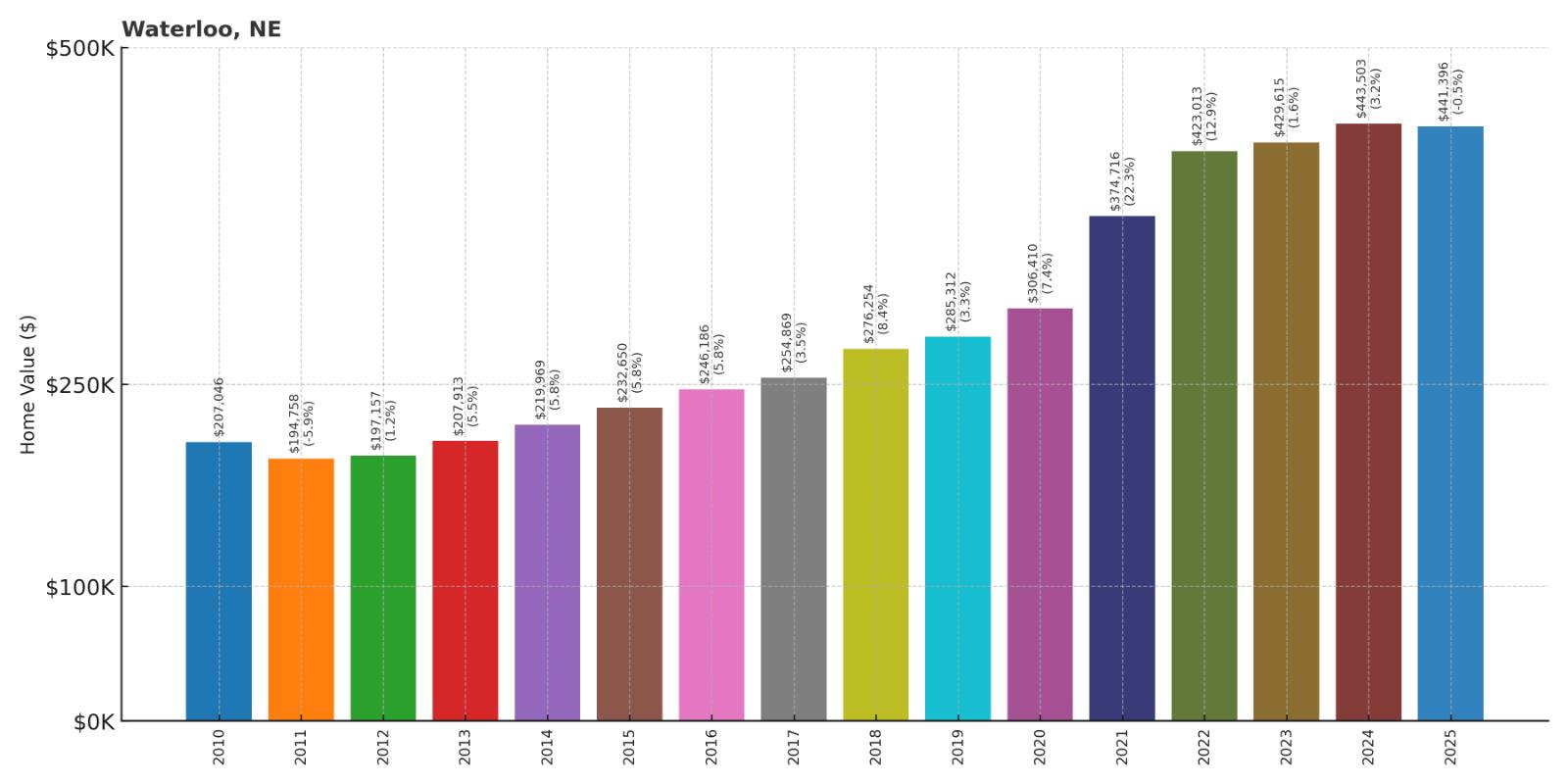
- 2010: $207,046
- 2011: $194,758
- 2012: $197,157
- 2013: $207,913
- 2014: $219,969
- 2015: $232,650
- 2016: $246,186
- 2017: $254,869
- 2018: $276,254
- 2019: $285,312
- 2020: $306,410
- 2021: $374,716
- 2022: $423,013
- 2023: $429,615
- 2024: $443,503
- 2025: $441,396
Waterloo has achieved strong appreciation with a 113% increase in home values since 2010, more than doubling from approximately $207,000 to over $441,000. The community showed steady growth throughout the 2010s, with significant acceleration during the pandemic years. This impressive performance reflects Waterloo’s growing recognition as a desirable suburban community in the Omaha metropolitan area.
Why Waterloo?

Why are people willing to pay so much to live here? What’s special about it?
Waterloo attracts residents as an established suburb in Douglas County with excellent schools and a strong sense of community. Families are drawn to the Waterloo Community Schools district and the city’s small-town atmosphere within the larger Omaha metropolitan area. The community offers well-maintained neighborhoods, parks, and recreational facilities that support family-oriented living.
The city’s location provides convenient access to Omaha employment centers while maintaining lower density living and community character. Waterloo features established neighborhoods with mature trees, local businesses, and community amenities that appeal to families and professionals. The combination of good schools, safe neighborhoods, and suburban conveniences creates an attractive living environment that supports strong property values.
How Waterloo Rose to Prominence
Founded in the 1860s as a farming community along the Elkhorn River, Waterloo developed around agricultural activities and early transportation routes. The town grew steadily through the early 1900s, serving local farms and maintaining its rural character. Railroad connections and later highway access supported modest growth and community development.
Significant residential growth began in the 1970s and accelerated through subsequent decades as Omaha’s suburban expansion reached Douglas County. The community invested in schools, parks, and infrastructure to support new residential development while preserving community character. Waterloo’s commitment to maintaining small-town charm while providing suburban amenities has made it an attractive choice for families seeking quality of life in the Omaha area.
3 Interesting Tidbits
1. River Heritage – The city’s location along the Elkhorn River provides scenic beauty and recreational opportunities including fishing and wildlife viewing.
2. Community Events – Annual festivals and community gatherings strengthen social bonds and celebrate the city’s heritage and character.
3. School Excellence – Waterloo Community Schools consistently rank among the top districts in the Omaha metropolitan area for academic achievement.
14. Garland – 126% Home Price Increase Since 2010

- 2010: $196,807
- 2011: $198,835
- 2012: $199,294
- 2013: $205,380
- 2014: $214,911
- 2015: $222,665
- 2016: $235,125
- 2017: $247,852
- 2018: $270,332
- 2019: $286,548
- 2020: $302,817
- 2021: $352,736
- 2022: $399,856
- 2023: $417,989
- 2024: $424,386
- 2025: $445,674
Garland has delivered impressive appreciation with a 126% increase in home values since 2010, rising from approximately $197,000 to over $445,000. The small village showed consistent growth throughout the decade, with significant acceleration during and after the pandemic years. This strong performance reflects growing recognition of Garland’s value as an affordable rural community with good location advantages.
Why Garland?

Why are people willing to pay so much to live here? What’s special about it?
Garland attracts residents seeking authentic small-town living about 30 miles west of Lincoln. Despite its small size with fewer than 300 residents, the village offers a peaceful rural atmosphere and friendly community connections that urban areas cannot provide. The town’s location along Highway 34 makes it accessible for commuting to Lincoln or other regional employment centers.
Property values remain attractive compared to urban areas, making Garland appealing to buyers seeking space and value for their investment. The community’s rural setting provides scenic agricultural views and outdoor recreational opportunities that appeal to those wanting escape from urban congestion. Low inventory and increasing interest in rural living have helped drive appreciation in this quiet farming community.
How Garland Rose to Prominence
Founded in the late 1800s as an agricultural settlement, Garland developed as a service point for surrounding farms and ranches. The village remained small and stable through most of the 20th century, serving local agricultural needs while maintaining its rural character. Railroad connections provided transportation links for agricultural commerce and community supplies.
Recent appreciation reflects increased demand for rural properties and small-town living, particularly among buyers seeking alternatives to urban housing costs. The village’s affordability and authentic character appeal to those wanting genuine rural experiences. While Garland remains small, its location and charm have attracted attention from buyers seeking peaceful living environments within reasonable distance of larger employment centers.
3 Interesting Tidbits
1. Small Scale – With fewer than 300 residents, Garland maintains the intimate community feel that many larger towns have lost to growth and development.
2. Agricultural Setting – The village sits in prime farming country with corn and soybean fields extending in all directions, providing classic rural scenery.
3. Community Bonds – Annual gatherings and volunteer activities create strong social connections among residents in this close-knit rural community.
13. Springfield – 109% Home Price Increase Since 2010

- 2010: $215,914
- 2011: $203,983
- 2012: $205,355
- 2013: $207,566
- 2014: $217,804
- 2015: $225,811
- 2016: $241,120
- 2017: $263,002
- 2018: $280,965
- 2019: $299,673
- 2020: $316,324
- 2021: $367,992
- 2022: $403,186
- 2023: $424,998
- 2024: $439,337
- 2025: $451,106
Springfield’s housing market has more than doubled since 2010, rising from $215,914 to over $451,000. Growth was steady through the 2010s, with momentum accelerating after 2020. The pandemic period brought particularly sharp gains, cementing Springfield as one of Sarpy County’s most valuable suburbs.
Why Springfield?

Why are people willing to pay so much to live here? What’s special about it?
Springfield offers a balance of small-town living with access to Omaha’s metropolitan opportunities. Families appreciate the Springfield Platteview Community Schools, known for strong academics and supportive teachers. The town’s location along Highway 50 makes commuting convenient for professionals working in Omaha.
The community also boasts scenic surroundings, including the Platte River State Park and nearby wildlife areas. Residents enjoy a slower pace of life while still benefiting from suburban amenities. This mix of affordability, access, and quality of life keeps Springfield in high demand.
How Springfield Rose to Prominence
Founded in the mid-1800s, Springfield developed as a farming hub along the Platte River valley. The railroad era bolstered its growth, providing crucial transport links for agriculture. Throughout the 20th century, Springfield remained a modest farming community with close ties to Omaha.
Its transformation came as Omaha’s suburbs expanded southward, drawing families looking for affordable homes and space. Investments in schools, infrastructure, and new subdivisions positioned Springfield as an attractive commuter town. The community’s ability to retain its rural charm while adding modern housing has sustained its popularity.
3 Interesting Tidbits
- Hollywood Connection – Scenes from the film “To Wong Foo, Thanks for Everything! Julie Newmar” were filmed in Springfield’s historic downtown.
- Community Events – Springfield hosts an annual Days Festival with parades, food, and live music, celebrating the town’s heritage.
- Art Legacy – The Springfield Artworks gallery showcases local glass and textile artists, adding cultural richness to the community.
12. Firth – 128% Home Price Increase Since 2010

- 2010: $200,197
- 2011: $197,454
- 2012: $192,187
- 2013: $205,229
- 2014: $214,952
- 2015: $229,944
- 2016: $243,806
- 2017: $257,600
- 2018: $281,348
- 2019: $294,835
- 2020: $308,392
- 2021: $359,199
- 2022: $416,484
- 2023: $419,825
- 2024: $439,451
- 2025: $456,846
Firth’s housing market has surged by 128% since 2010, growing from $200,197 to more than $456,000. Prices rose steadily through the 2010s, with the strongest acceleration during the pandemic years. Today, Firth represents one of Lancaster County’s most sought-after rural communities.
Why Firth?

Why are people willing to pay so much to live here? What’s special about it?
Firth combines small-town living with easy access to Lincoln, located about 20 miles away. Families appreciate the Norris School District, which consistently performs well academically. The town also offers large lots and newer subdivisions that provide space and privacy.
Community life remains vibrant with local churches, parks, and youth programs that strengthen neighborhood ties. The rural setting adds to the appeal, offering scenic farmland views and outdoor recreation. These qualities make Firth especially attractive for young families and professionals commuting to Lincoln.
How Firth Rose to Prominence
Founded in the late 1800s as a railroad and farming community, Firth thrived as an agricultural service hub. Grain elevators and farm-based commerce defined much of its history. The arrival of suburban expansion from Lincoln in the late 20th century transformed it into a commuter town.
Housing developments and infrastructure investments boosted its desirability through the 2000s. Proximity to Lincoln and strong schools further solidified its reputation. Today, Firth balances historic rural roots with modern suburban growth.
3 Interesting Tidbits
- School Excellence – Firth feeds into the Norris School District, regarded as one of the best in the Lincoln area.
- Historic Charm – Grain elevators still stand as reminders of the town’s agricultural heritage.
- Outdoor Fun – The area offers quick access to Bluestem State Recreation Area, popular for camping and fishing.
11. Malmo – 169% Home Price Increase Since 2010
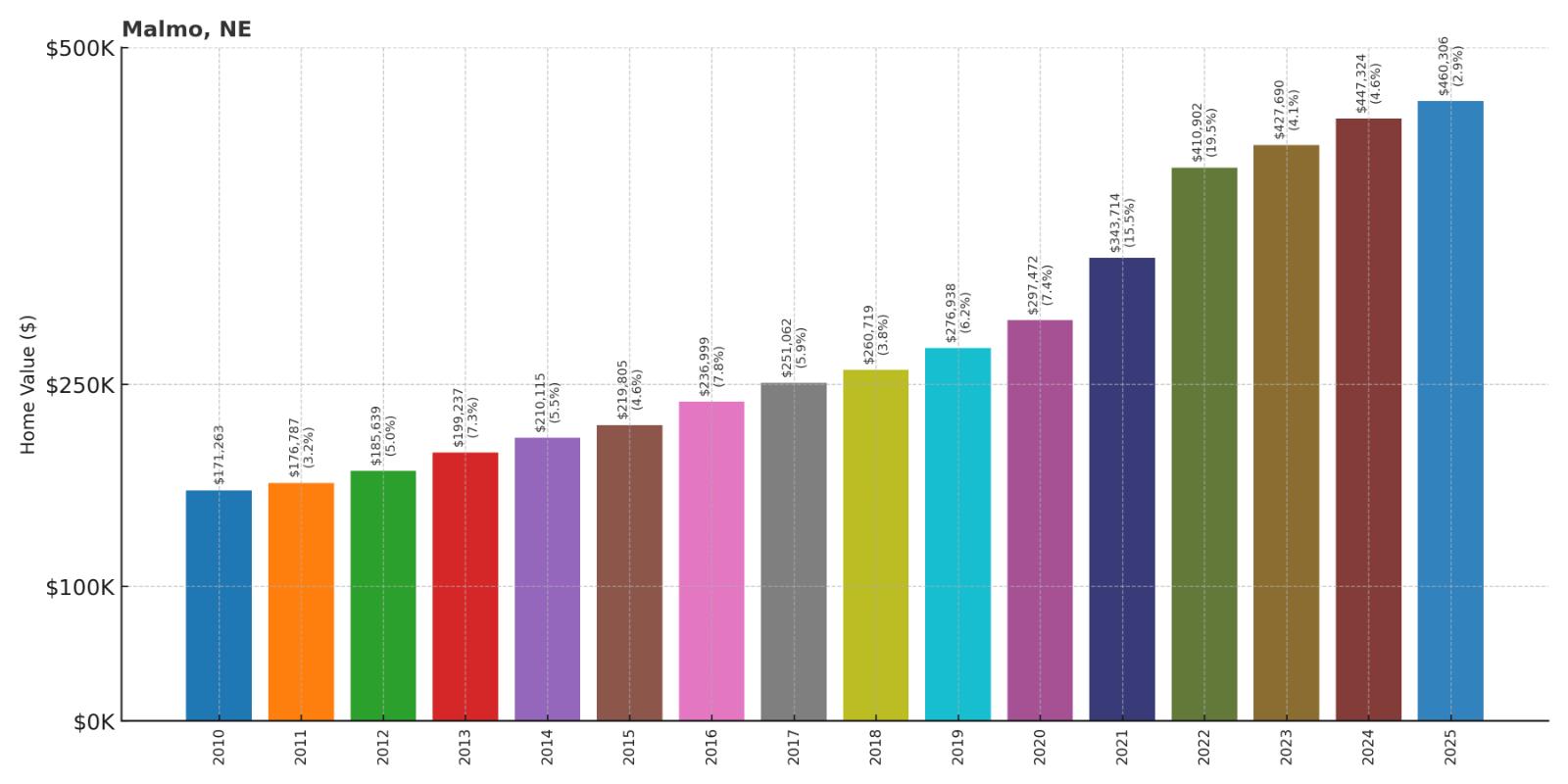
- 2010: $171,263
- 2011: $176,787
- 2012: $185,639
- 2013: $199,237
- 2014: $210,115
- 2015: $219,805
- 2016: $236,999
- 2017: $251,062
- 2018: $260,719
- 2019: $276,938
- 2020: $297,472
- 2021: $343,714
- 2022: $410,902
- 2023: $427,690
- 2024: $447,324
- 2025: $460,306
Malmo’s home prices have soared 169% since 2010, rising from $171,263 to more than $460,000. The strongest gains occurred between 2020 and 2023, with prices increasing by more than $130,000 in just three years. This remarkable growth highlights the rising interest in rural Saunders County communities.
Why Malmo?
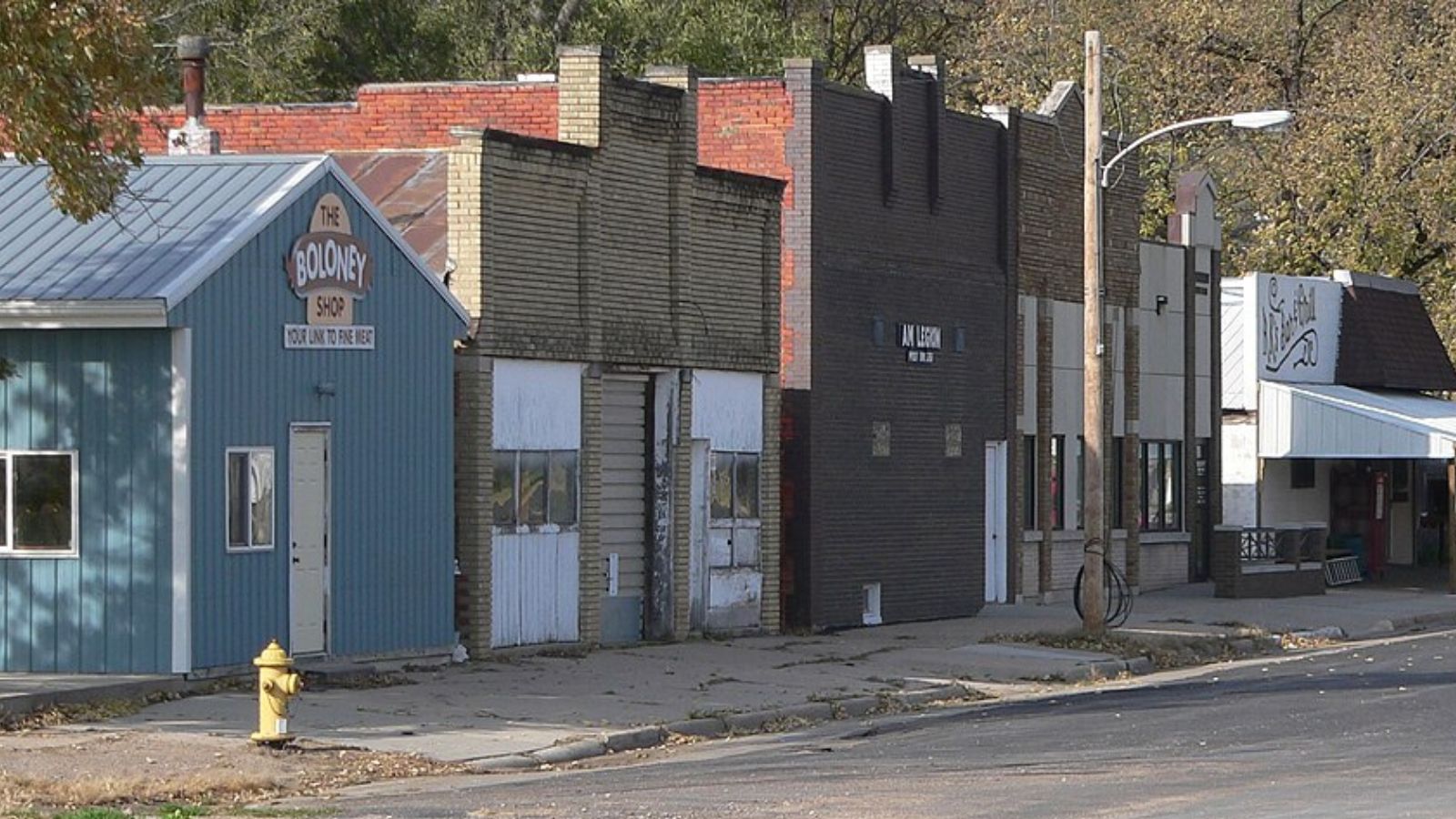
Why are people willing to pay so much to live here? What’s special about it?
Malmo offers buyers quiet rural living within reach of both Lincoln and Omaha. Its agricultural backdrop creates scenic surroundings that appeal to those seeking open space. Residents value the tight-knit community and safe environment that small towns provide.
Low property taxes and affordable living costs further add to its appeal. Families also benefit from access to good schools and community facilities. Malmo’s combination of charm, affordability, and location explains its surge in demand.
How Malmo Rose to Prominence
Founded in the late 19th century, Malmo’s name reflects the Swedish immigrants who settled in the area. Agriculture formed the backbone of the town, with farms and grain elevators dominating its economy. Like many small Nebraska towns, Malmo saw slow but steady growth through the 20th century.
In recent decades, its proximity to larger cities has made it attractive to commuters. Remote work and rising urban housing costs have further boosted interest. Malmo now represents a desirable blend of history and modern living.
3 Interesting Tidbits
- Scandinavian Roots – Malmo was named after the city of Malmö, Sweden, honoring its immigrant founders.
- Historic Church – The Malmo Evangelical Covenant Church has been a community landmark since the early 1900s.
- Rural Recreation – Residents enjoy nearby lakes and hunting grounds that define local outdoor life.
10. Davey – 109% Home Price Increase Since 2010
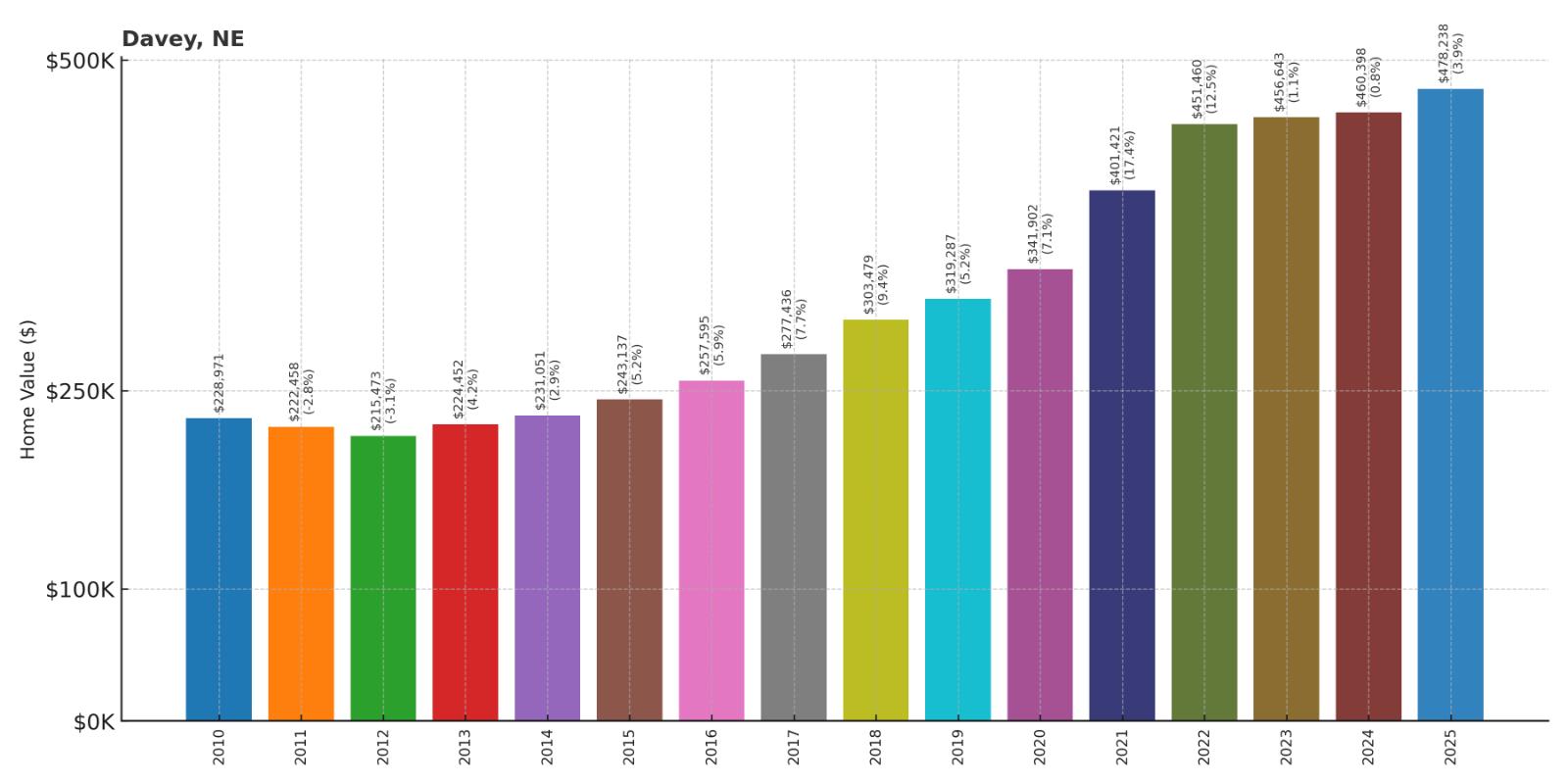
- 2010: $228,971
- 2011: $222,458
- 2012: $215,473
- 2013: $224,452
- 2014: $231,051
- 2015: $243,137
- 2016: $257,595
- 2017: $277,436
- 2018: $303,479
- 2019: $319,287
- 2020: $341,902
- 2021: $401,421
- 2022: $451,460
- 2023: $456,643
- 2024: $460,398
- 2025: $478,238
Davey’s home values have more than doubled since 2010, rising from $228,971 to nearly $478,000. Growth was steady in the early 2010s but surged after 2020, adding more than $130,000 in just five years. This trajectory underscores Davey’s growing desirability in Lancaster County.
Why Davey?

Why are people willing to pay so much to live here? What’s special about it?
Davey appeals to families who want country living without losing access to Lincoln, just 15 miles away. The community offers larger lots and modern housing options that provide space and comfort. Its quiet setting also creates a sense of safety and belonging.
Residents enjoy small-town amenities, local businesses, and community gatherings that strengthen ties. Proximity to outdoor recreation, including state recreation areas, enhances its appeal. Buyers see Davey as a balance of affordability, location, and lifestyle.
How Davey Rose to Prominence
Founded in the late 1800s as a railroad town, Davey initially grew around agriculture and rail commerce. Its modest size limited expansion throughout the 20th century. For decades, it was primarily known as a rural farming village.
The rise of suburban demand shifted its fortunes, with Lincoln’s expansion bringing new interest. Remote work trends and modern housing developments further drove growth. Today, Davey has become one of the area’s more desirable commuter towns.
3 Interesting Tidbits
- Railroad Legacy – Davey was named after William Davey, a railroad superintendent.
- Close-Knit – The community maintains a population under 200, preserving strong social ties.
- Historic Grain – Old elevators remain as landmarks of its agricultural past.
9. Pleasant Dale – 132% Home Price Increase Since 2010
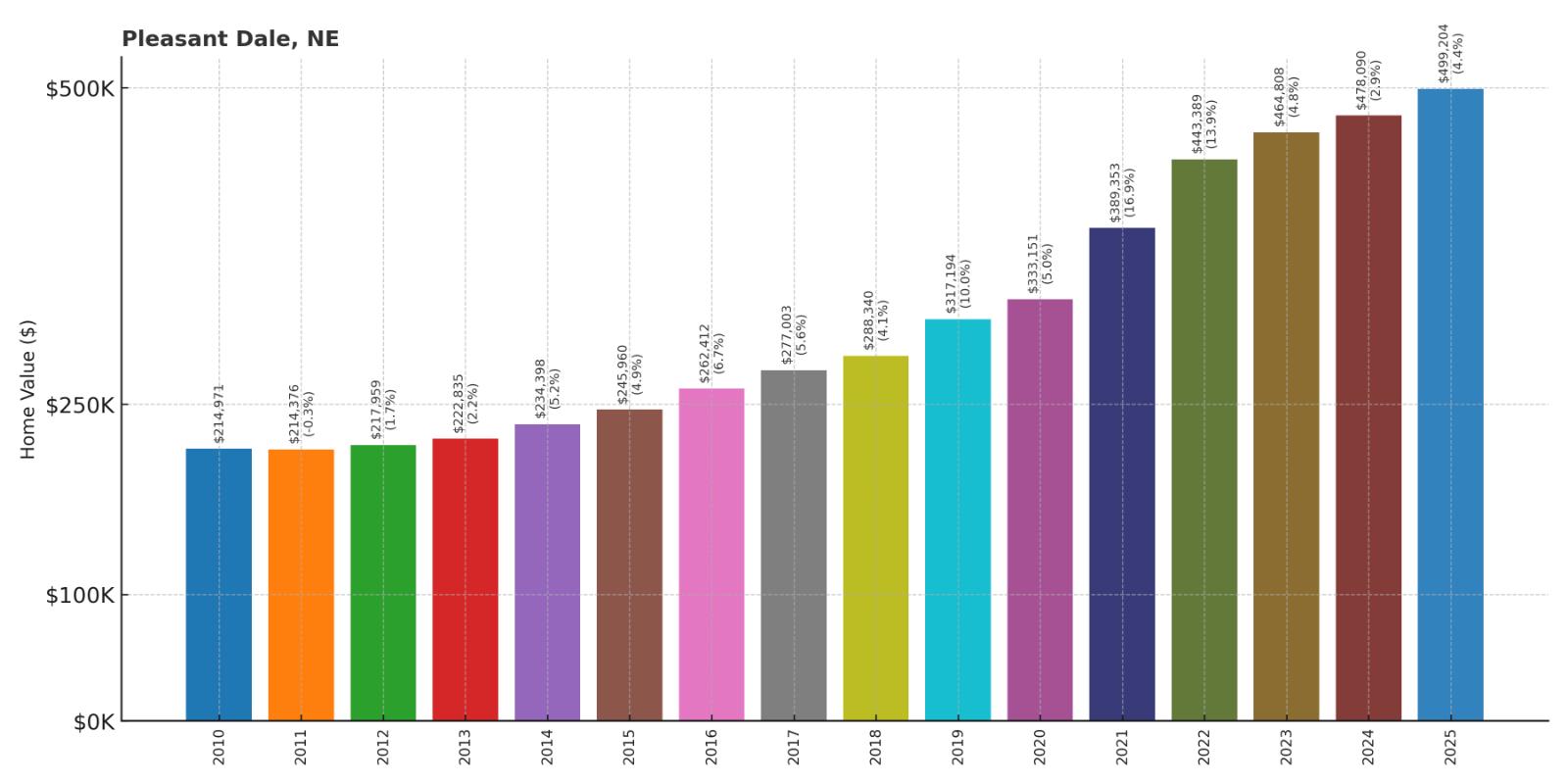
- 2010: $214,971
- 2011: $214,376
- 2012: $217,959
- 2013: $222,835
- 2014: $234,398
- 2015: $245,960
- 2016: $262,412
- 2017: $277,003
- 2018: $288,340
- 2019: $317,194
- 2020: $333,151
- 2021: $389,353
- 2022: $443,389
- 2023: $464,808
- 2024: $478,090
- 2025: $499,204
Pleasant Dale’s market has jumped 132% since 2010, reaching nearly $500,000 in 2025. Values rose steadily in the 2010s, then accelerated after 2020. This steady climb reflects strong demand for Lancaster County’s smaller towns.
Why Pleasant Dale?

Why are people willing to pay so much to live here? What’s special about it?
Located just west of Lincoln, Pleasant Dale offers an easy commute into the capital while maintaining rural charm. The town is known for its welcoming atmosphere and community-focused way of life. Families are drawn to affordable housing with more space than city options provide.
Outdoor enthusiasts appreciate access to nearby Branched Oak Lake and other recreation areas. The quiet, safe streets appeal to families and retirees alike. These lifestyle benefits explain the premium placed on Pleasant Dale homes.
How Pleasant Dale Rose to Prominence
Pleasant Dale began as a farming and railroad town in the 19th century. For much of its history, it remained a small agricultural service hub. Like many nearby communities, growth accelerated as Lincoln expanded westward.
Recent interest has been fueled by remote work, suburban expansion, and a desire for country living. The town’s affordable housing and location have kept demand high. Pleasant Dale has become a reliable choice for buyers seeking rural life with urban access.
3 Interesting Tidbits
- Historic Roots – Its name comes from the area’s original settlers, who admired the “pleasant” valleys.
- Close to Nature – Nearby Branched Oak Lake provides camping, fishing, and boating.
- Community Feel – Annual town events strengthen neighborly connections in this small village.
8. Valley – 104% Home Price Increase Since 2010
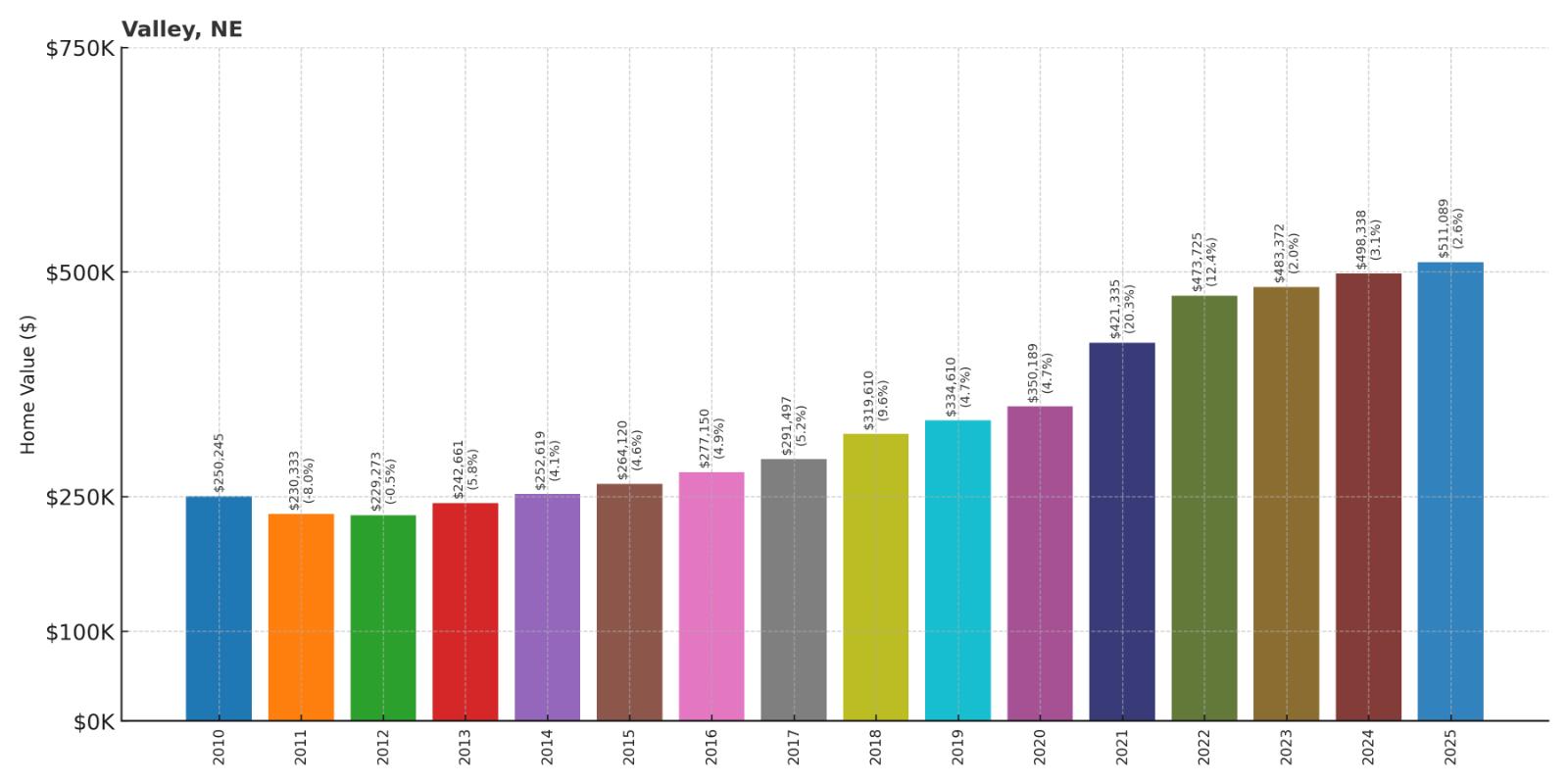
- 2010: $250,245
- 2011: $230,333
- 2012: $229,273
- 2013: $242,661
- 2014: $252,619
- 2015: $264,120
- 2016: $277,150
- 2017: $291,497
- 2018: $319,610
- 2019: $334,610
- 2020: $350,189
- 2021: $421,335
- 2022: $473,725
- 2023: $483,372
- 2024: $498,338
- 2025: $511,089
Valley’s home prices have more than doubled since 2010, rising from $250,245 to over $511,000. Growth took off after 2020, with values jumping by more than $160,000 in just five years. This performance cements Valley as one of Douglas County’s top housing markets.
Why Valley?

Why are people willing to pay so much to live here? What’s special about it?
Valley benefits from a lakeside lifestyle, with popular private lake communities like Ginger Cove. Waterfront properties add significant value compared to other rural towns. The setting attracts both year-round residents and second-home buyers seeking recreation.
Its proximity to Omaha makes commuting easy while still offering a relaxed lifestyle. Local amenities include parks, marinas, and small-town businesses. These unique advantages push demand far above average rural markets.
How Valley Rose to Prominence
Valley was founded as a railroad and farming town but later became famous for its private lakes. Ginger Cove, developed in the 1960s, turned the area into a recreational hub. The combination of water access and Omaha’s suburban growth transformed the community.
High demand for lakefront property drove rapid appreciation in recent decades. Investments in residential development and amenities added momentum. Valley’s lakeside reputation now defines its housing market strength.
3 Interesting Tidbits
- Lakeside Living – Ginger Cove and other private lakes draw boaters, swimmers, and anglers year-round.
- Historic Floods – Valley’s location near rivers has made flood control a major part of its history.
- Railroad Origins – Its founding was tied to the Union Pacific Railroad expansion.
7. Malcolm – 146% Home Price Increase Since 2010
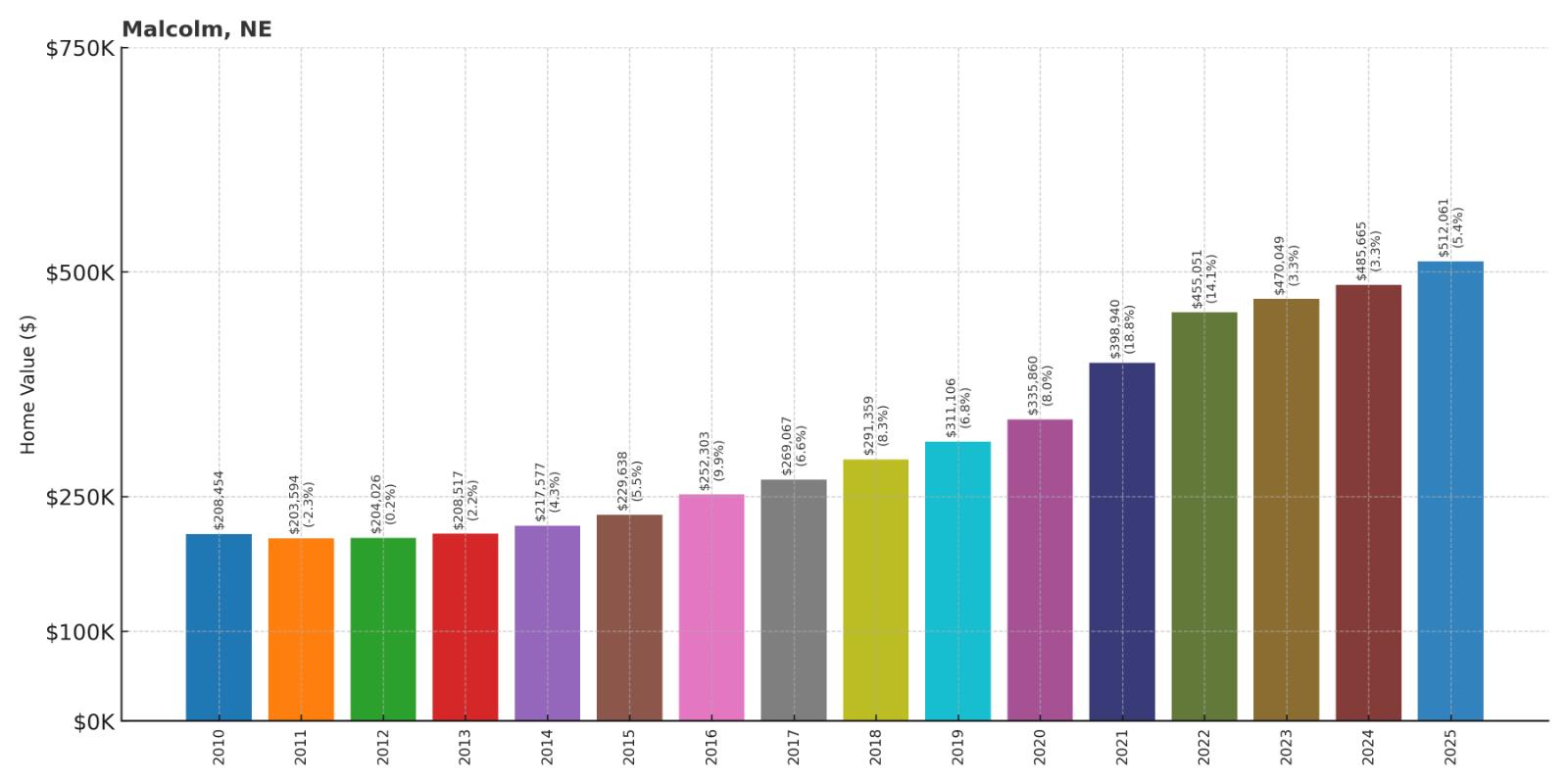
- 2010: $208,454
- 2011: $203,594
- 2012: $204,026
- 2013: $208,517
- 2014: $217,577
- 2015: $229,638
- 2016: $252,303
- 2017: $269,067
- 2018: $291,359
- 2019: $311,106
- 2020: $335,860
- 2021: $398,940
- 2022: $455,051
- 2023: $470,049
- 2024: $485,665
- 2025: $512,061
Malcolm’s home prices have risen 146% since 2010, climbing from $208,454 to more than $512,000. Appreciation was steady through the 2010s, then accelerated dramatically during the pandemic. The trend highlights Malcolm’s desirability as a rural town near Lincoln.
Why Malcolm?

Why are people willing to pay so much to live here? What’s special about it?
Malcolm appeals to families looking for space and excellent schools while remaining close to Lincoln. It is part of the Malcolm Public Schools district, known for strong performance. Residents enjoy quiet living without losing access to jobs and city amenities.
The town offers a family-friendly environment with sports, community events, and parks. Large residential lots give homeowners more privacy compared to city subdivisions. These factors make Malcolm especially popular with commuters and families alike.
How Malcolm Rose to Prominence
Founded in the late 19th century, Malcolm developed as an agricultural hub. Farming defined the town’s economy for much of its history. In recent decades, suburban expansion from Lincoln brought population growth.
Remote work trends and rising urban housing costs boosted interest during the pandemic. The combination of strong schools and affordable space further accelerated demand. Malcolm now represents one of the most attractive commuter options in Lancaster County.
3 Interesting Tidbits
- School Strength – Malcolm’s public schools are among the top-rated rural districts in Nebraska.
- Community Events – Annual town days bring residents together for parades, food, and music.
- Outdoor Appeal – Branched Oak Lake is only a few miles away, offering boating and camping.
6. Fort Calhoun – 123% Home Price Increase Since 2010
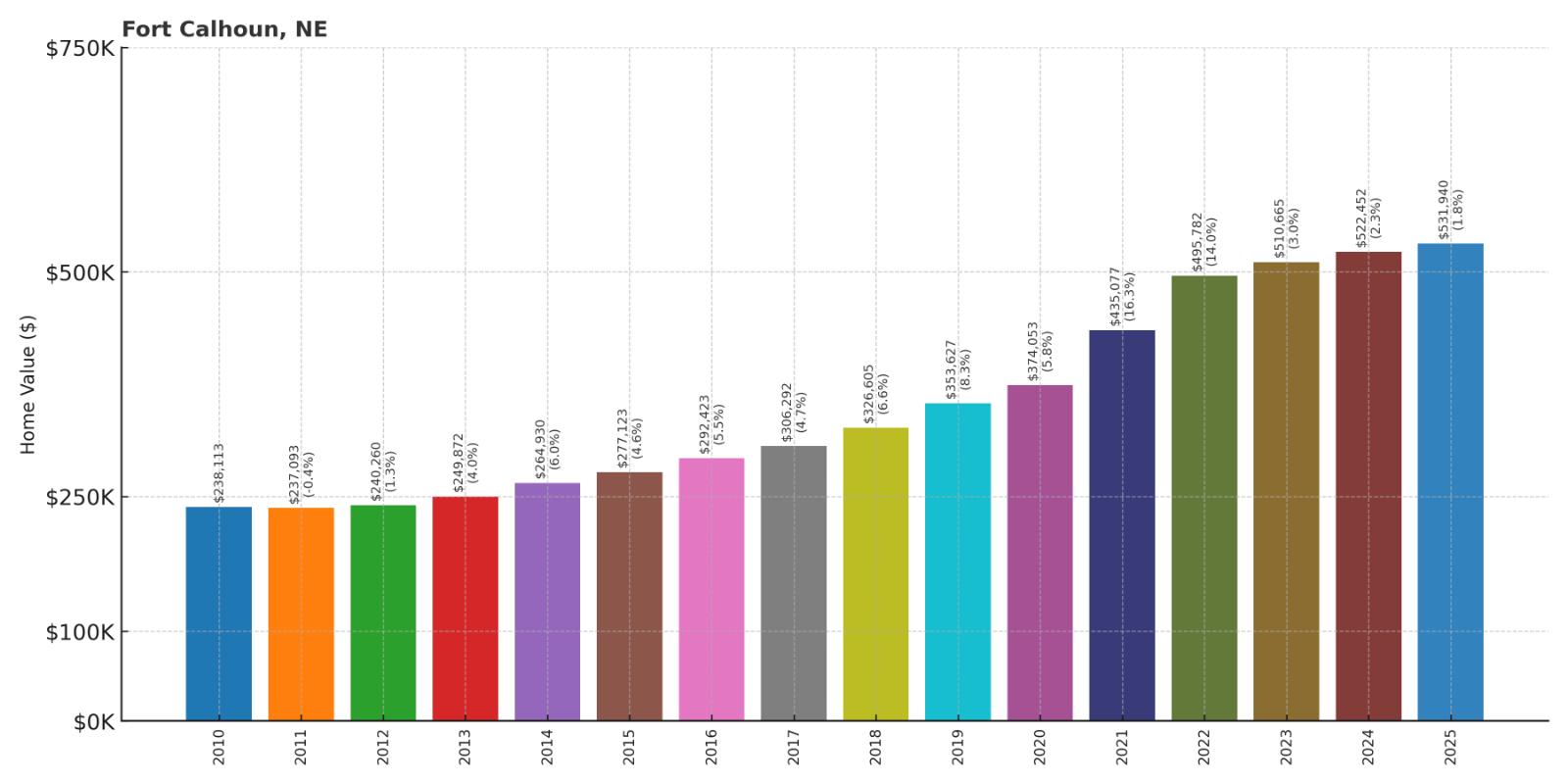
- 2010: $238,113
- 2011: $237,093
- 2012: $240,260
- 2013: $249,872
- 2014: $264,930
- 2015: $277,123
- 2016: $292,423
- 2017: $306,292
- 2018: $326,605
- 2019: $353,627
- 2020: $374,053
- 2021: $435,077
- 2022: $495,782
- 2023: $510,665
- 2024: $522,452
- 2025: $531,940
Fort Calhoun has more than doubled in value since 2010, rising 123% from $238,113 to $531,940. The largest gains came after 2020, when prices rose by more than $150,000 in just five years. Its unique history and location have made it one of Washington County’s strongest markets.
Why Fort Calhoun?

Why are people willing to pay so much to live here? What’s special about it?
Fort Calhoun is rich in history, being the oldest town in Nebraska, founded in 1855. Its proximity to Omaha makes it appealing for commuters. Families enjoy the safe environment, small-town charm, and local amenities.
Homes here offer more space and privacy compared to city properties. Access to nearby nature preserves and the Missouri River adds recreational appeal. These qualities help explain Fort Calhoun’s strong housing demand.
How Fort Calhoun Rose to Prominence
The town began as a military fort, established in 1819, and later became a permanent settlement. Agriculture dominated its economy for decades. Its historic identity, coupled with Omaha’s suburban expansion, spurred steady growth.
In recent decades, Fort Calhoun has balanced preservation of its history with new development. Schools, parks, and infrastructure have supported population growth. The result is a thriving small town with deep roots and modern appeal.
3 Interesting Tidbits
- Historic Fort – The nearby Fort Atkinson State Historical Park commemorates the original 1819 military post.
- Oldest Town – Fort Calhoun holds the distinction of being Nebraska’s first incorporated town.
- River Access – Residents enjoy proximity to the Missouri River for boating and fishing.
5. Martell – 138% Home Price Increase Since 2010
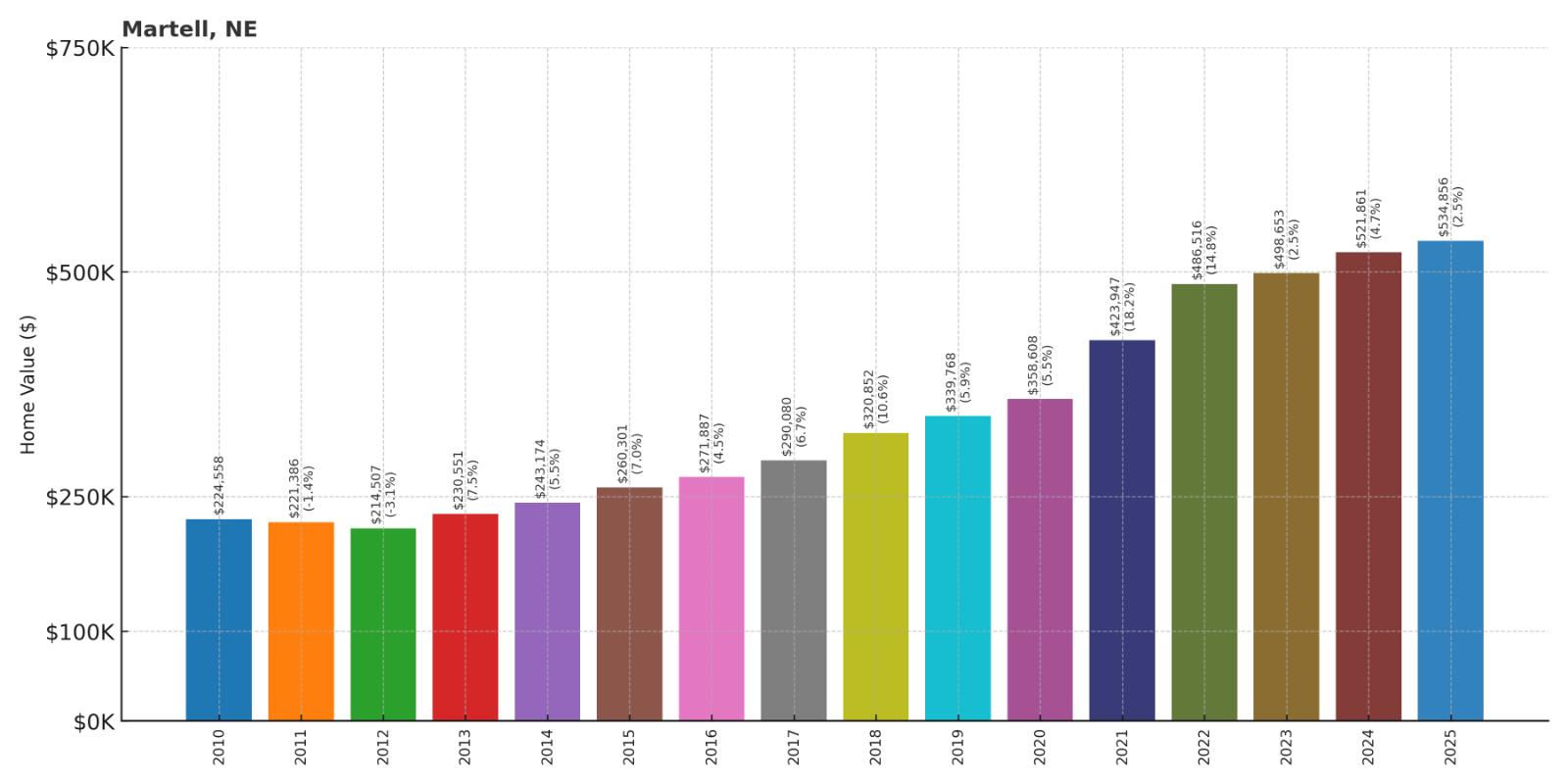
- 2010: $224,558
- 2011: $221,386
- 2012: $214,507
- 2013: $230,551
- 2014: $243,174
- 2015: $260,301
- 2016: $271,887
- 2017: $290,080
- 2018: $320,852
- 2019: $339,768
- 2020: $358,608
- 2021: $423,947
- 2022: $486,516
- 2023: $498,653
- 2024: $521,861
- 2025: $534,856
Martell’s home values have risen 138% since 2010, increasing from $224,558 to more than $534,000. Appreciation was steady but accelerated sharply during the pandemic years. Today, Martell is one of Lancaster County’s fastest-rising housing markets.
Why Martell?

Why are people willing to pay so much to live here? What’s special about it?
Martell offers a quiet rural lifestyle just southwest of Lincoln. Residents value the small-town atmosphere, friendly neighbors, and wide-open farmland views. The community appeals to those seeking more space and affordability than city life provides.
Its location allows easy access to Lincoln while maintaining lower property taxes. Families benefit from good schools and youth programs. The blend of location, affordability, and community has fueled Martell’s housing growth.
How Martell Rose to Prominence
Martell began as a railroad stop and agricultural hub in the 19th century. Farming remained central to its economy throughout much of its history. Its proximity to Lincoln created opportunities for commuters as the city expanded.
Recent housing demand accelerated due to remote work and suburban migration. With limited housing inventory, values increased rapidly. Martell now represents one of the more desirable rural communities near Lincoln.
3 Interesting Tidbits
- Historic Roots – Martell developed around a Chicago, Rock Island & Pacific Railroad stop.
- Quiet Living – The town’s small size keeps it peaceful, with fewer than 500 residents.
- Farmland Views – Vast agricultural fields define the surrounding landscape.
4. Raymond – 122% Home Price Increase Since 2010

- 2010: $254,674
- 2011: $253,085
- 2012: $247,445
- 2013: $261,743
- 2014: $274,463
- 2015: $291,002
- 2016: $311,383
- 2017: $331,637
- 2018: $358,265
- 2019: $373,345
- 2020: $393,495
- 2021: $469,262
- 2022: $528,098
- 2023: $533,344
- 2024: $547,199
- 2025: $565,238
Raymond has experienced a 122% increase in home prices since 2010, jumping from $254,674 to more than $565,000. Growth was gradual at first, but post-2020 gains accelerated. This reflects Raymond’s rising reputation as a premium rural location near Lincoln.
Why Raymond?

Why are people willing to pay so much to live here? What’s special about it?
Raymond offers buyers larger properties, quiet surroundings, and a strong sense of community. Its location just northwest of Lincoln makes it ideal for commuters. The area also benefits from proximity to Branched Oak Lake and Pawnee State Recreation Area.
Families enjoy the safety and slower pace that comes with rural life. Residents also appreciate lower density housing and wide-open landscapes. These features justify Raymond’s steadily rising property values.
How Raymond Rose to Prominence
Raymond was founded in the late 1800s as a farming settlement. Like many nearby villages, its early economy revolved around grain and livestock. The town grew slowly through the 20th century, maintaining its agricultural roots.
As Lincoln’s influence expanded, Raymond gained attention as a rural commuter town. Investments in infrastructure and schools further added to its draw. The town’s location and scenic surroundings have driven steady appreciation.
3 Interesting Tidbits
- Outdoor Paradise – Raymond is close to Branched Oak Lake, one of Nebraska’s largest reservoirs.
- Small-Town Feel – Fewer than 200 residents call Raymond home, keeping its community tight-knit.
- Historic Center – Old grain elevators still mark the town’s farming heritage.
3. Roca – 109% Home Price Increase Since 2010
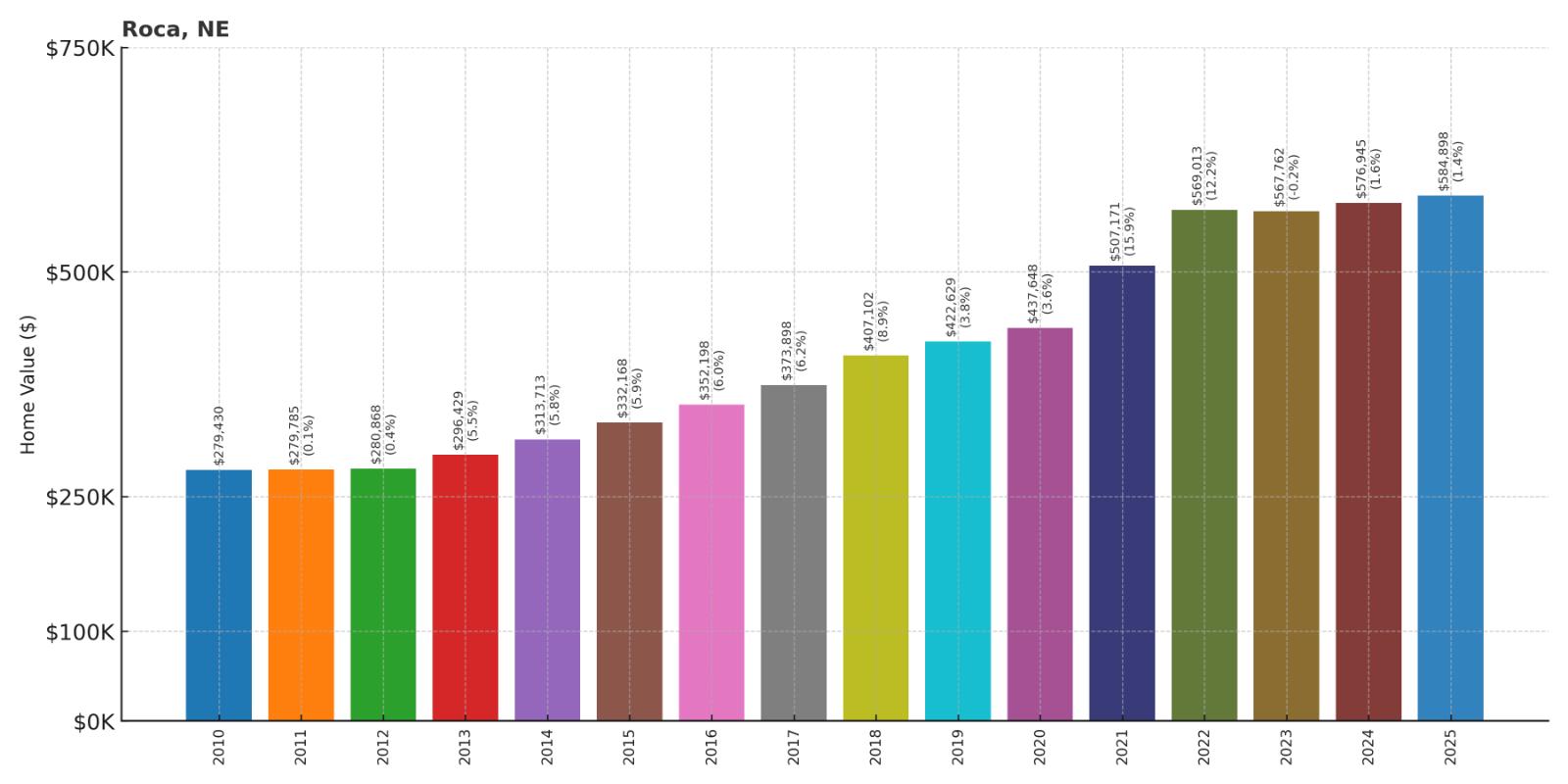
- 2010: $279,430
- 2011: $279,785
- 2012: $280,868
- 2013: $296,429
- 2014: $313,713
- 2015: $332,168
- 2016: $352,198
- 2017: $373,898
- 2018: $407,102
- 2019: $422,629
- 2020: $437,648
- 2021: $507,171
- 2022: $569,013
- 2023: $567,762
- 2024: $576,945
- 2025: $584,898
Roca’s housing market has grown by 109% since 2010, rising from $279,430 to nearly $585,000. Prices climbed steadily throughout the 2010s, with a sharp acceleration post-2020. This growth highlights the community’s appeal in Lancaster County.
Why Roca?

Why are people willing to pay so much to live here? What’s special about it?
Roca is just a short drive south of Lincoln, making it ideal for commuters. Its rural character and affordable taxes are attractive to families. Large lots and custom-built homes offer more space than city neighborhoods.
The community is also known for Roca Berry Farm, a local attraction that brings seasonal visitors. Residents enjoy a mix of peaceful rural life with recreational opportunities nearby. These advantages make Roca one of Lancaster County’s pricier rural towns.
How Roca Rose to Prominence
Founded in the 1870s as a stone quarry town, Roca’s name means “rock” in Spanish. Agriculture later became its backbone, supporting steady but modest growth. The quarry and grain trade shaped its early history.
In the 21st century, suburban migration from Lincoln reshaped the town’s housing market. Remote work trends and lifestyle preferences boosted demand after 2020. Today, Roca stands out for its unique blend of history, location, and rural charm.
3 Interesting Tidbits
- Berry Farm – Roca Berry Farm is a regional favorite for pumpkin patches and seasonal activities.
- Quarry History – The town’s name comes from its limestone quarry operations in the 19th century.
- Population Size – Roca remains a small village, with fewer than 300 residents.
2. Denton – 139% Home Price Increase Since 2010
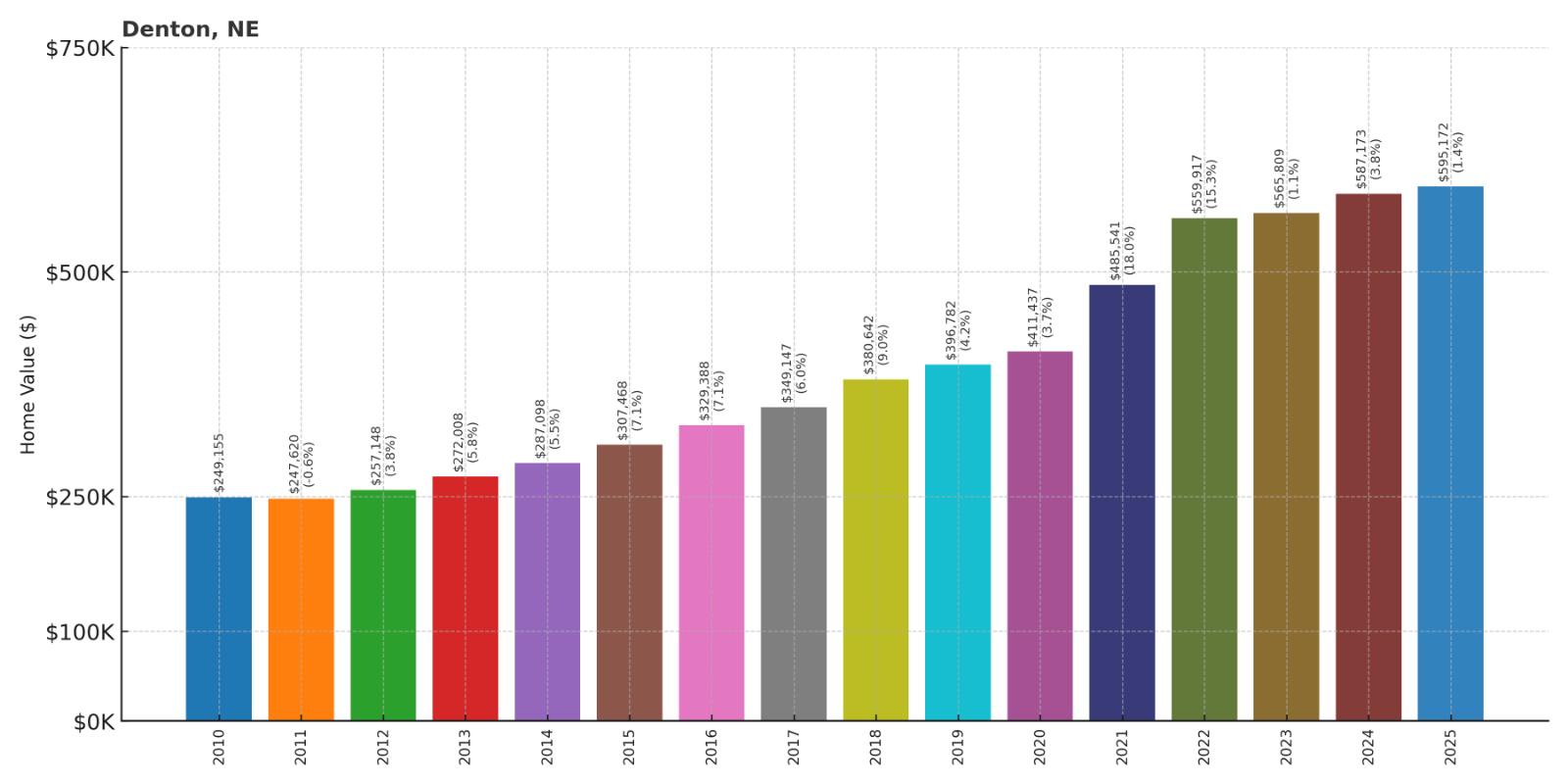
- 2010: $249,155
- 2011: $247,620
- 2012: $257,148
- 2013: $272,008
- 2014: $287,098
- 2015: $307,468
- 2016: $329,388
- 2017: $349,147
- 2018: $380,642
- 2019: $396,782
- 2020: $411,437
- 2021: $485,541
- 2022: $559,917
- 2023: $565,809
- 2024: $587,173
- 2025: $595,172
Denton’s home values have surged 139% since 2010, climbing from $249,155 to more than $595,000. Appreciation has been steady across the years, with pandemic-era growth particularly notable. Denton is now one of Lancaster County’s most expensive towns.
Why Denton?

Why are people willing to pay so much to live here? What’s special about it?
Denton combines rural character with proximity to Lincoln, only 10 miles away. Families appreciate the safe environment and quality schools in the Norris District. The village offers large properties and quiet surroundings not available in urban areas.
Recreational opportunities nearby, including Wagon Train Lake, add appeal. Lower population density means more privacy and space for homeowners. These lifestyle advantages have contributed to Denton’s rapid rise in value.
How Denton Rose to Prominence
Denton was founded in the 1870s and quickly became a grain shipping point. Agriculture dominated its economy for much of its history. Its small size kept growth modest for decades.
As Lincoln expanded, Denton became an appealing commuter town. Housing demand accelerated during the 21st century, with the pandemic driving further increases. Today, Denton blends rural tranquility with convenient city access.
3 Interesting Tidbits
- Religious Landmark – Denton is home to the Our Lady of Guadalupe Seminary, an international Catholic institution.
- Natural Beauty – Wagon Train Lake State Recreation Area is a nearby attraction.
- Historic Grain – The community retains ties to its farming past with active grain elevators.
1. Walton – 81% Home Price Increase Since 2010
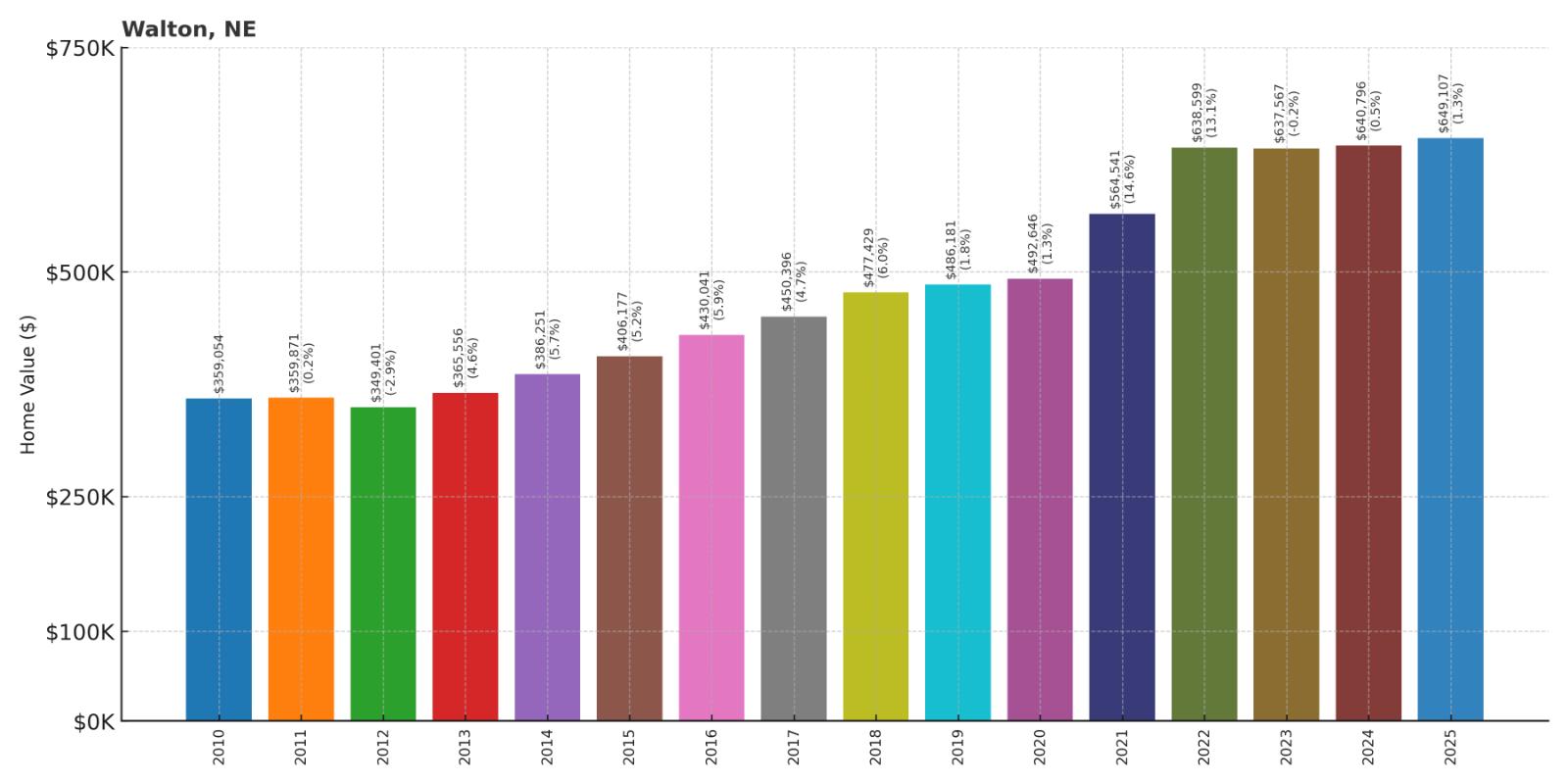
- 2010: $359,054
- 2011: $359,871
- 2012: $349,401
- 2013: $365,556
- 2014: $386,251
- 2015: $406,177
- 2016: $430,041
- 2017: $450,396
- 2018: $477,429
- 2019: $486,181
- 2020: $492,646
- 2021: $564,541
- 2022: $638,599
- 2023: $637,567
- 2024: $640,796
- 2025: $649,107
Walton tops the list with the highest home values in Nebraska, reaching $649,107 in 2025. Prices have risen 81% since 2010, making Walton a premier housing market despite slower percentage growth compared to smaller towns. Its already-high starting values set it apart as Nebraska’s most expensive community.
Why Walton?
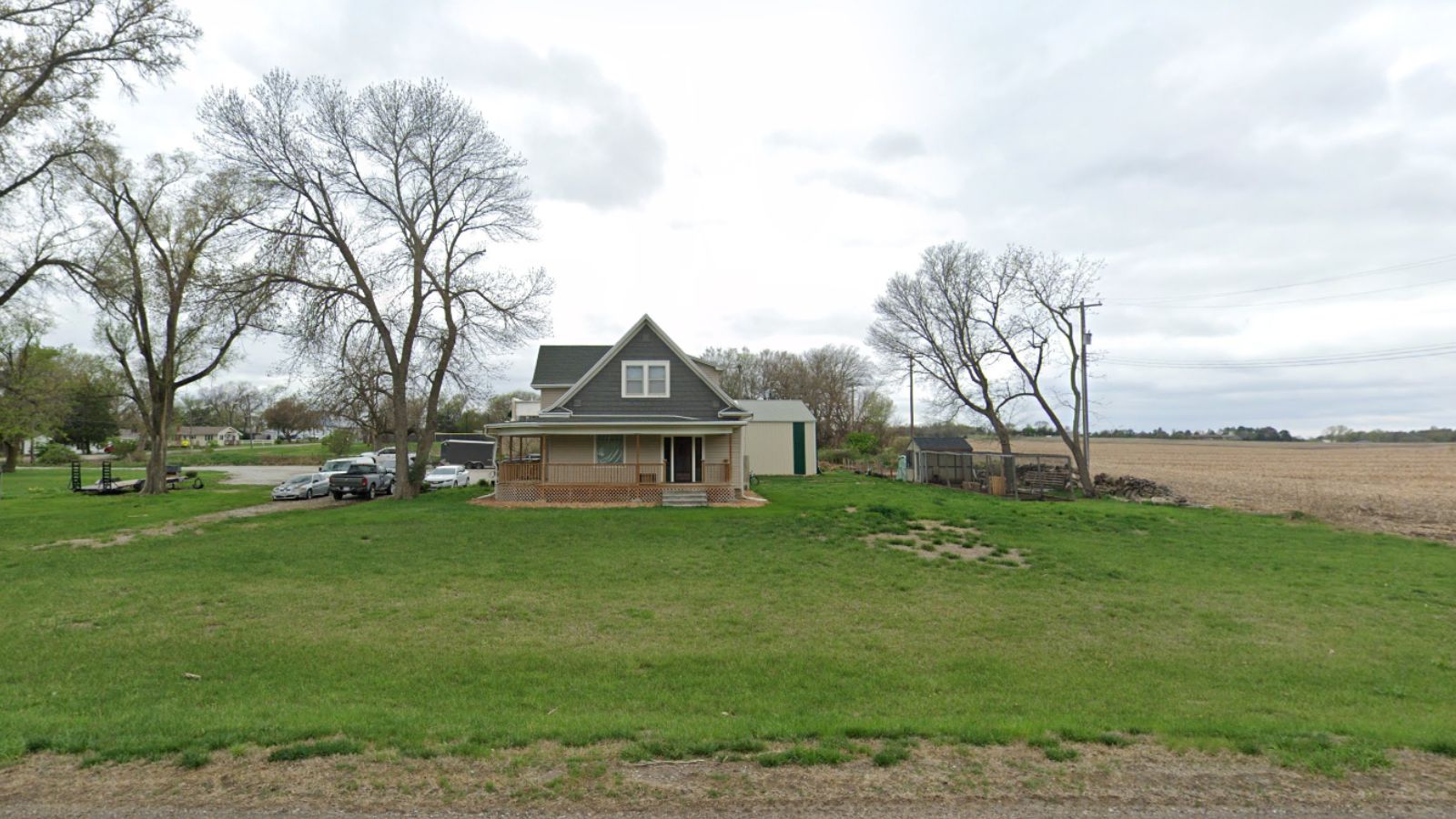
Why are people willing to pay so much to live here? What’s special about it?
Walton sits just east of Lincoln, making it an ideal commuter location. Large homes on spacious lots attract high-income professionals and families. The community also benefits from excellent schools and a safe environment.
Its semi-rural setting offers privacy while remaining minutes from city amenities. Scenic farmland surrounds the town, adding to its charm. These qualities combine to make Walton the most valuable town in Nebraska.
How Walton Rose to Prominence
Walton began in the late 1800s as a farming and railroad community. Its close proximity to Lincoln fueled gradual suburban growth. By the late 20th century, it had become a commuter hub for professionals.
High demand for luxury housing pushed values higher over time. With limited land and sustained demand, Walton’s prices have consistently remained at the top. Today, it is Nebraska’s most exclusive residential market.
3 Interesting Tidbits
- Top Schools – Walton is part of the Lincoln Public Schools system, offering strong educational opportunities.
- High Values – Despite slower growth percentages, Walton leads the state in absolute home prices.
- Historic Roots – Grain elevators and rail connections still mark Walton’s agricultural past.
